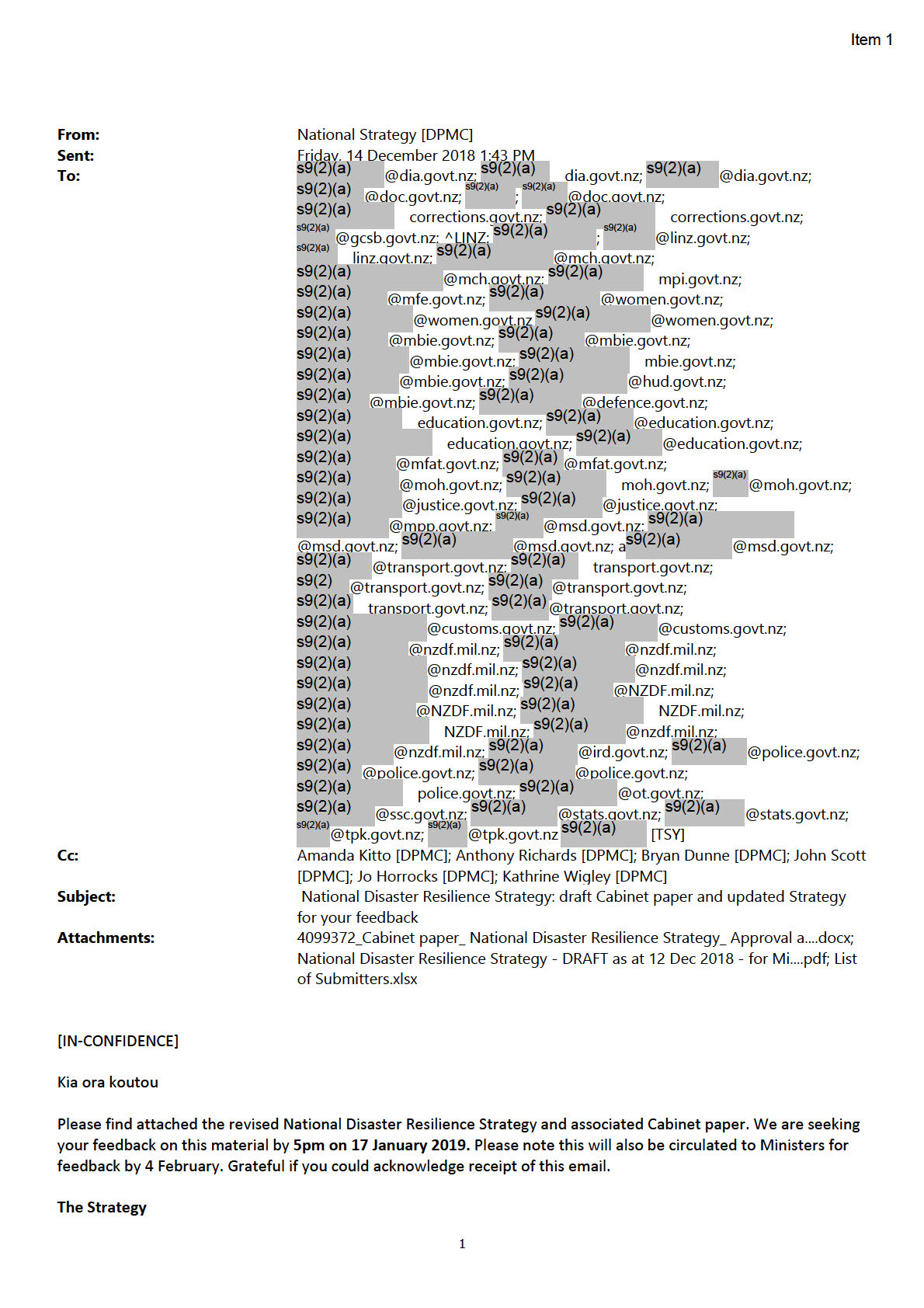
1982
Act
Information
Official
the
under
Released
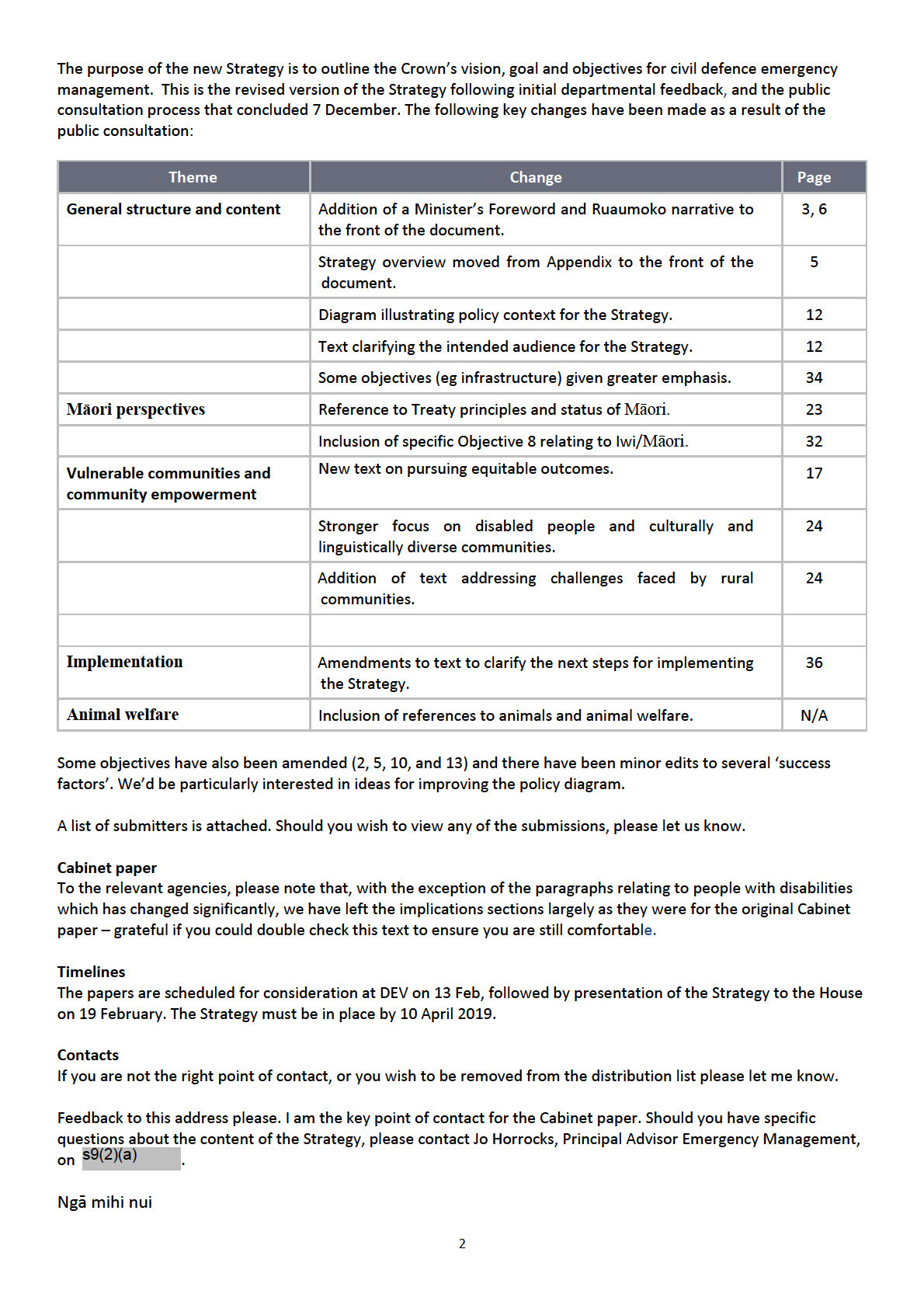
1982
Act
Information
Official
the
under
Released

 Kathrine Wigley
Kathrine Wigley
Senior Policy Advisor, National Security Policy
Directorate
National Security Group
Department of the Prime Minister and Cabinet
M s9(2)(a)
DDI s9(2)(a)
E s9(2)(a)
1982
Act
The information contained in this email message is for the attention of the
intended recipient only and is not necessarily the official view or
communication of the Department of the Prime Minister and Cabinet. If you
are not the intended recipient you must not disclose, copy or distribute this
message or the information in it. If you have received this message in error,
please destroy the email and notify the sender immediately.
Information
Official
the
under
Released
3
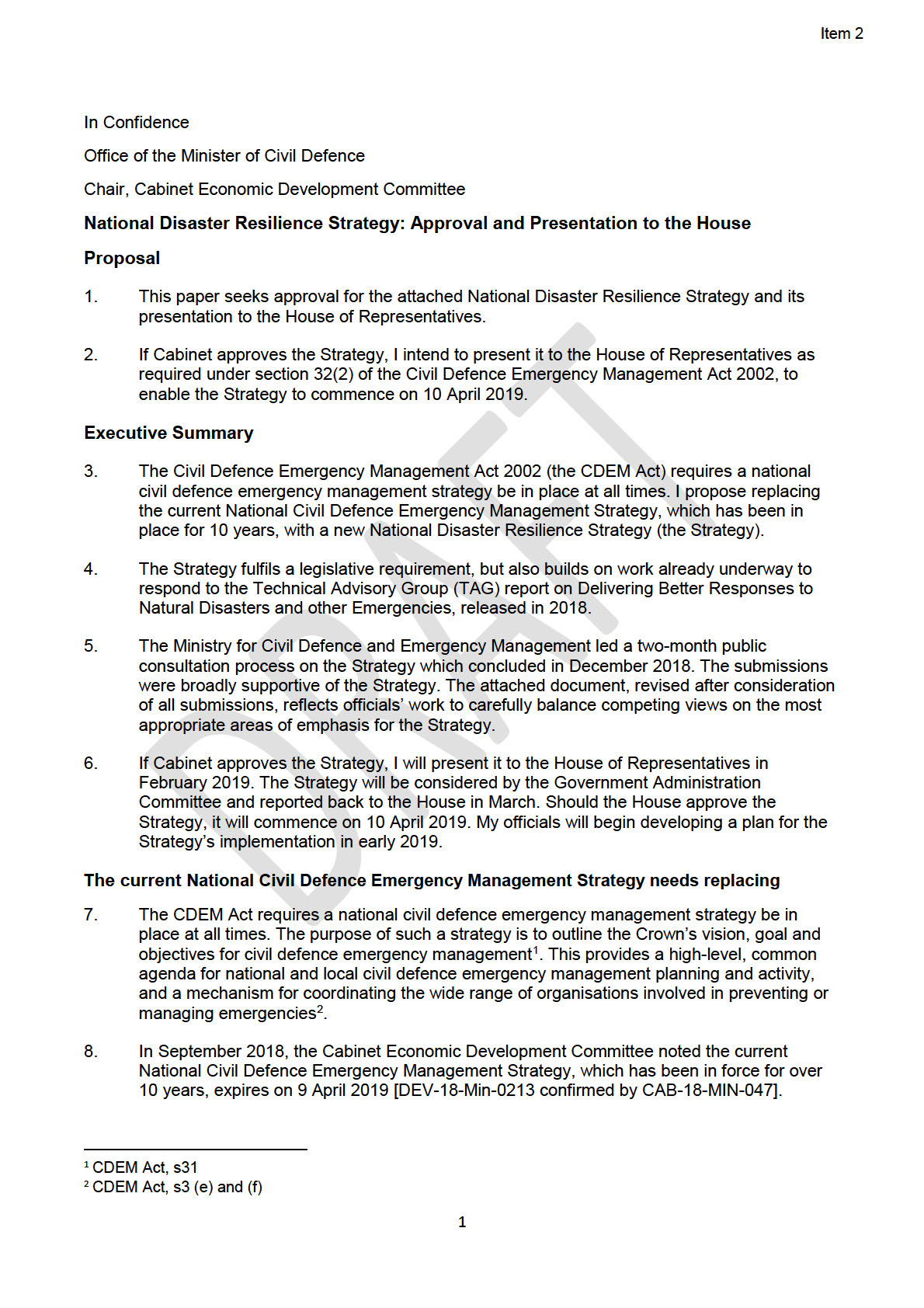
1982
Act
Information
Official
the
under
Released
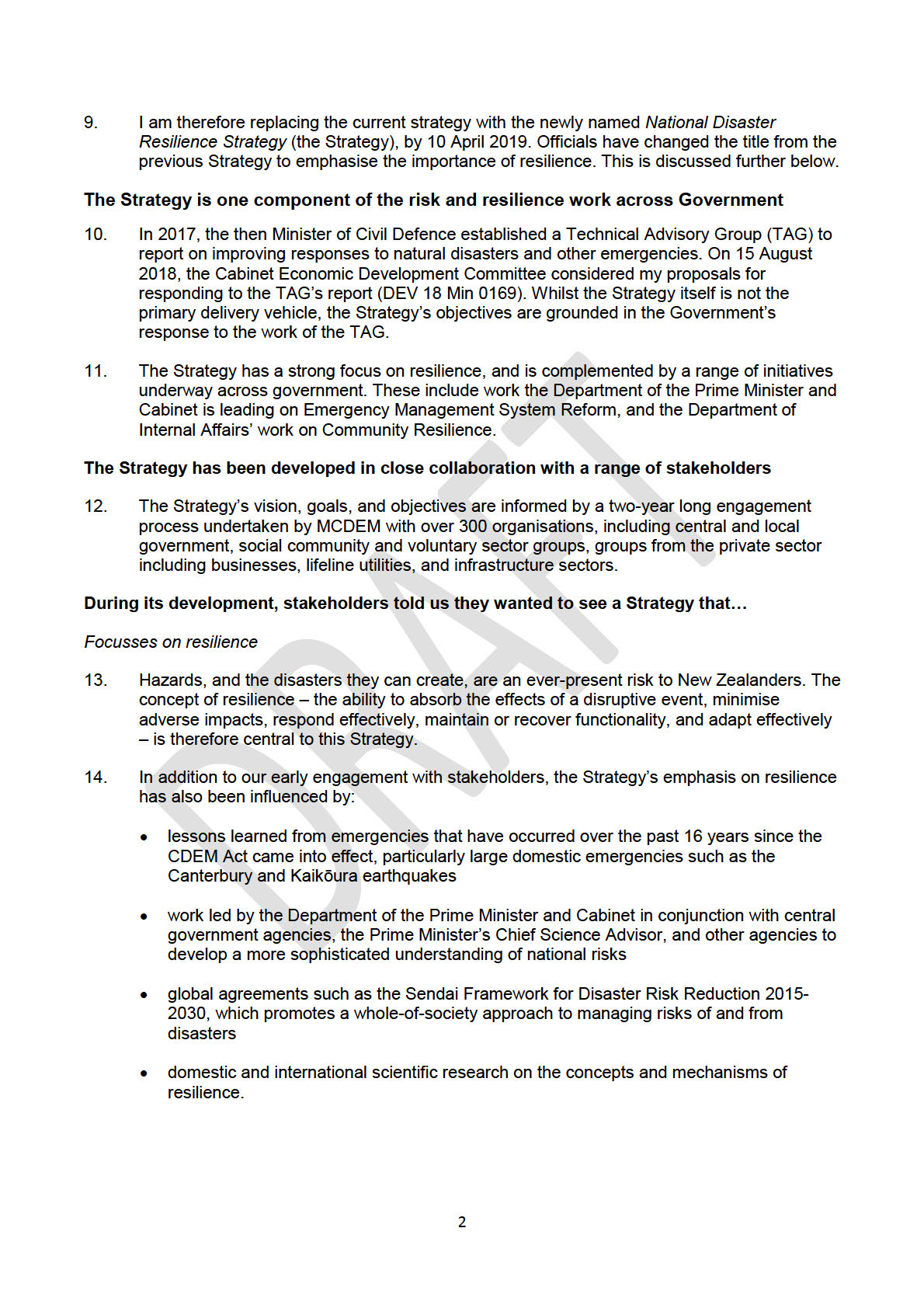
1982
Act
Information
Official
the
under
Released
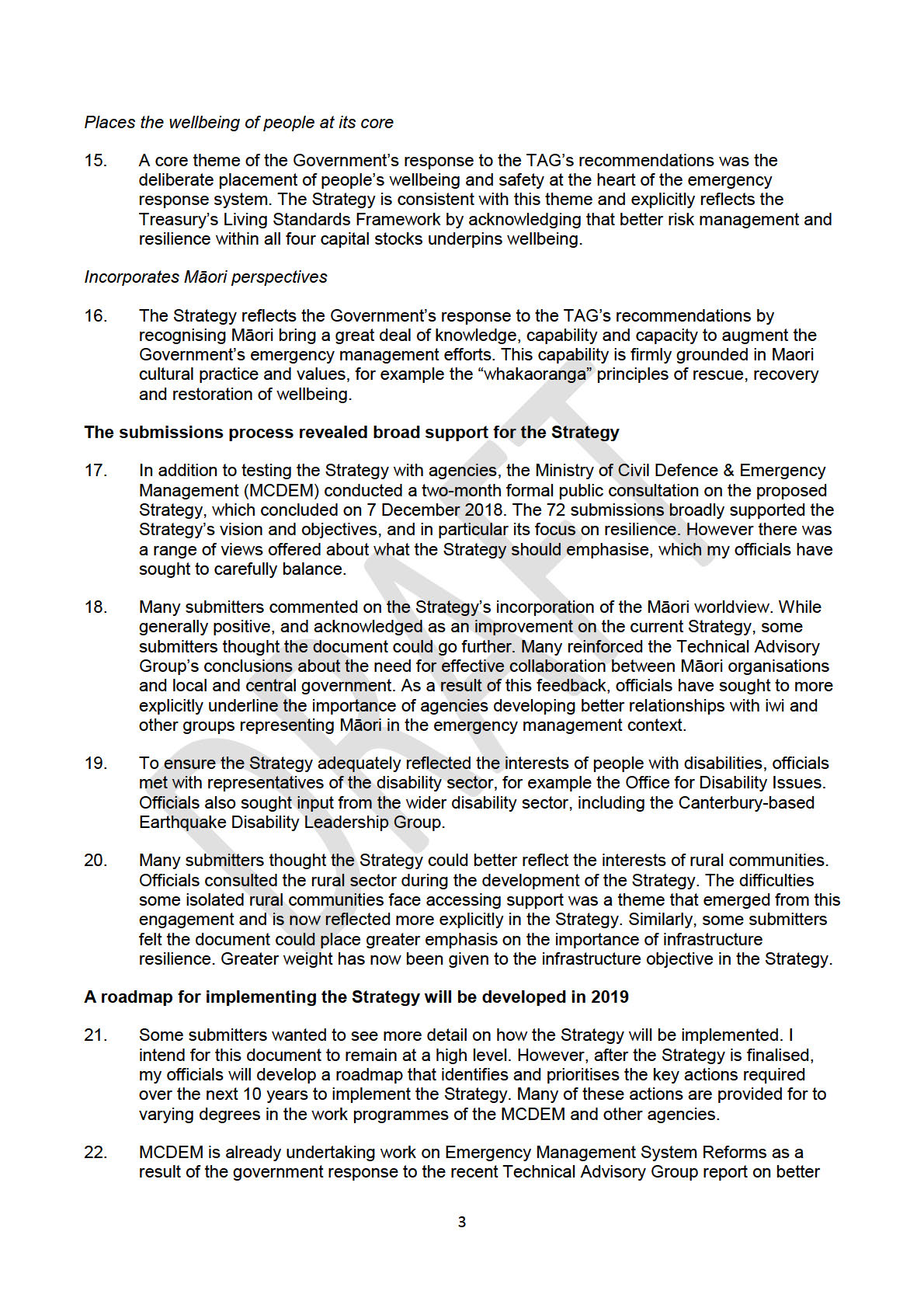
1982
Act
Information
Official
the
under
Released
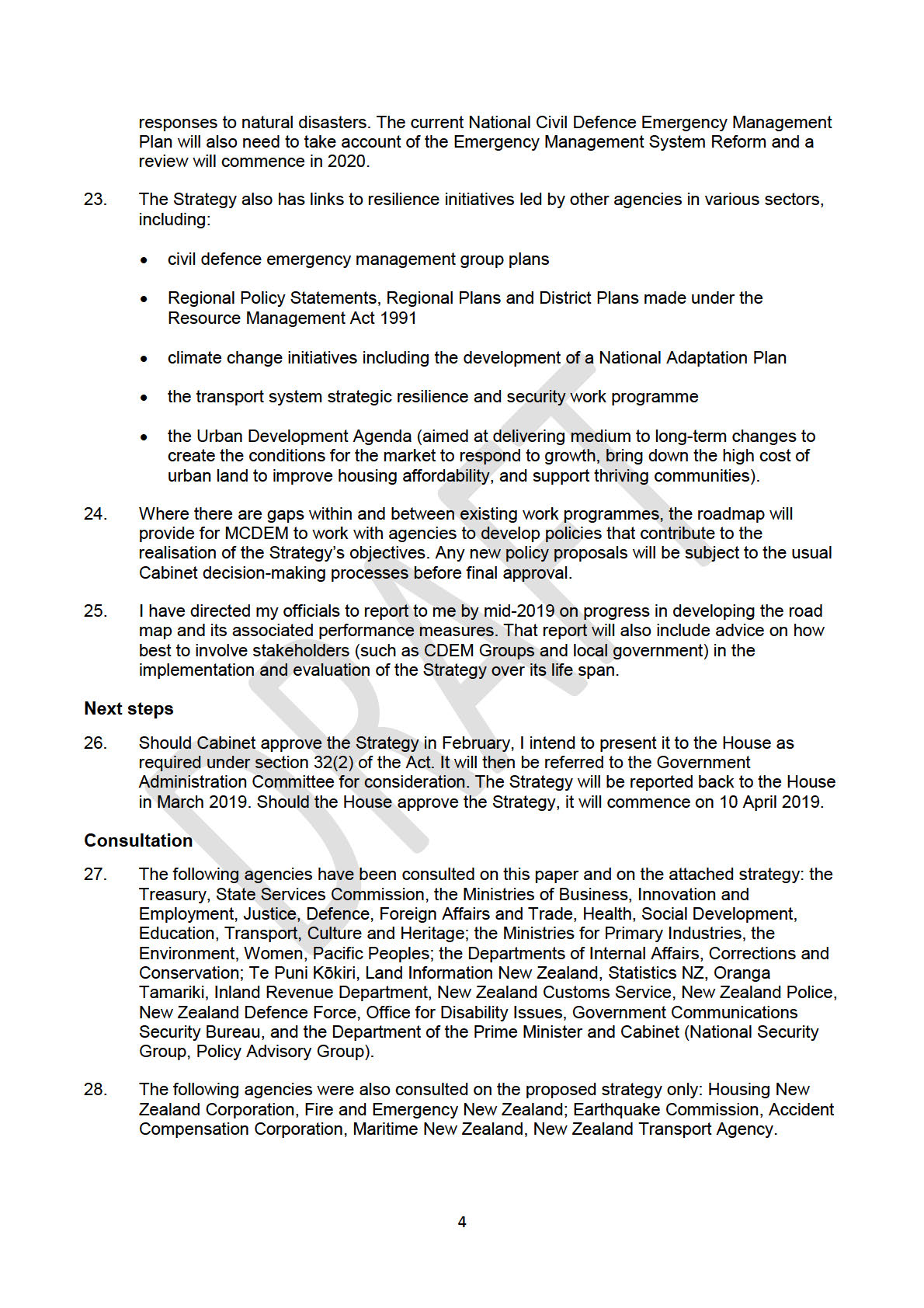
1982
Act
Information
Official
the
under
Released
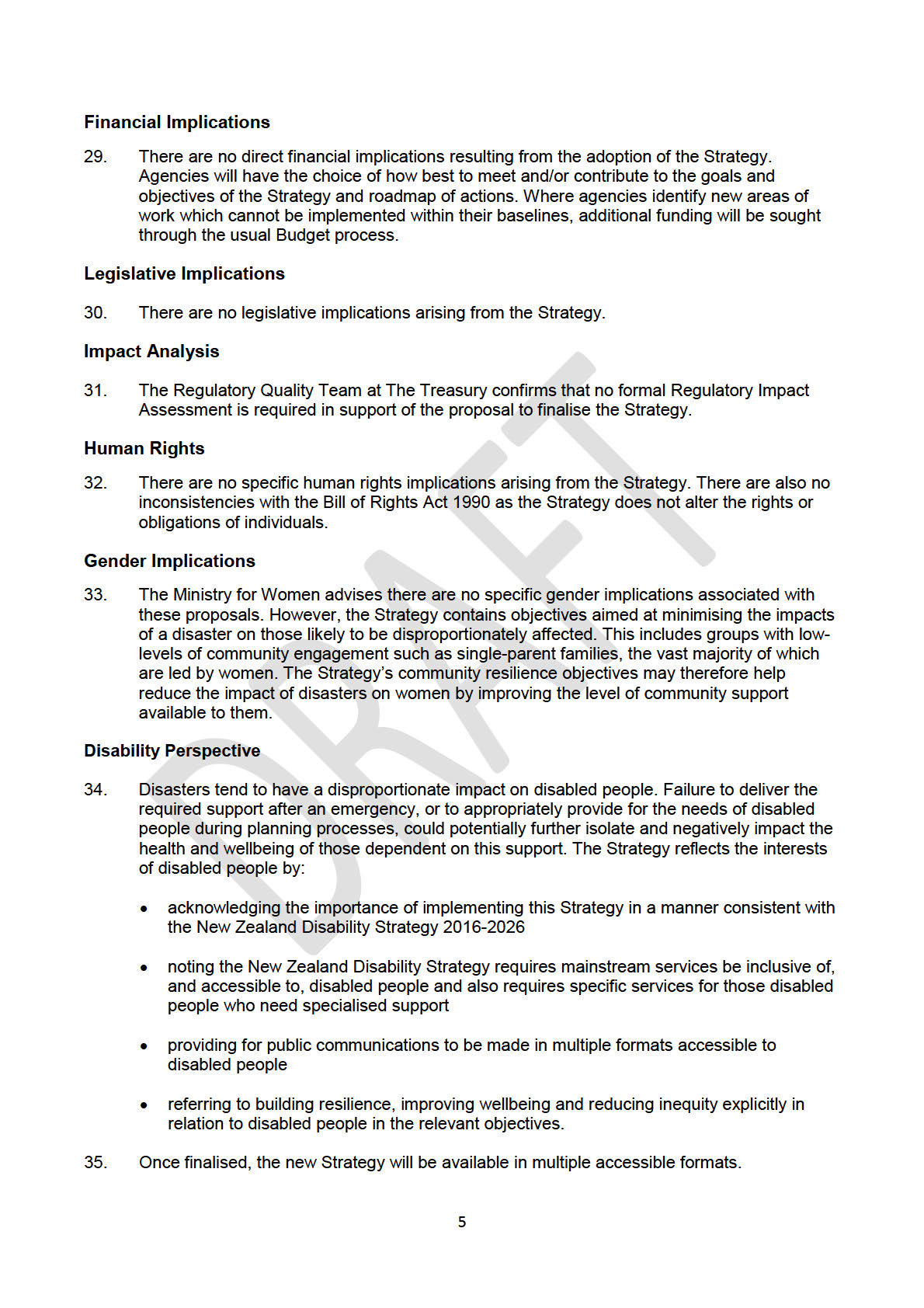
1982
Act
Information
Official
the
under
Released
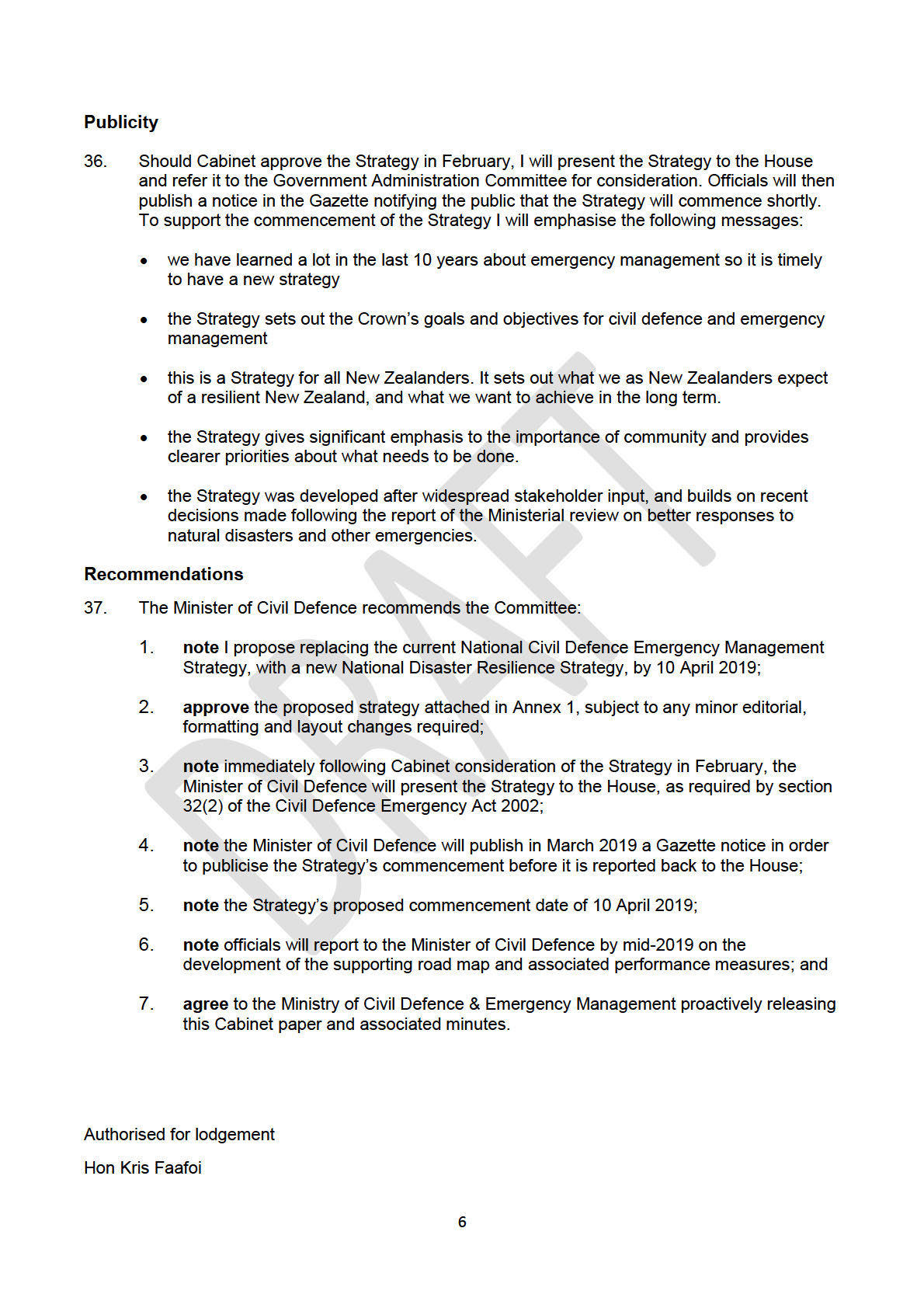
1982
Act
Information
Official
the
under
Released
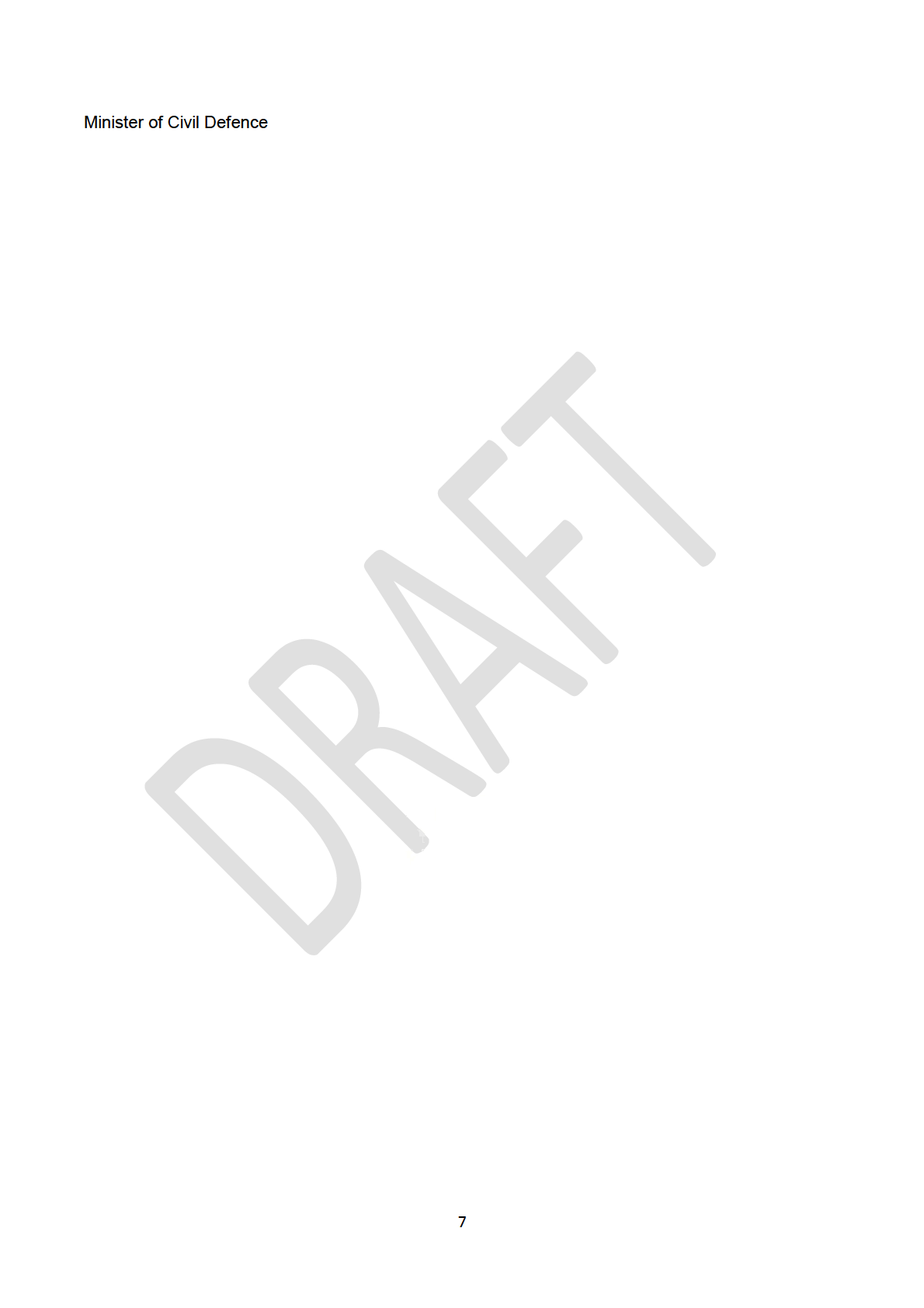
1982
Act
Information
Official
the
under
Released
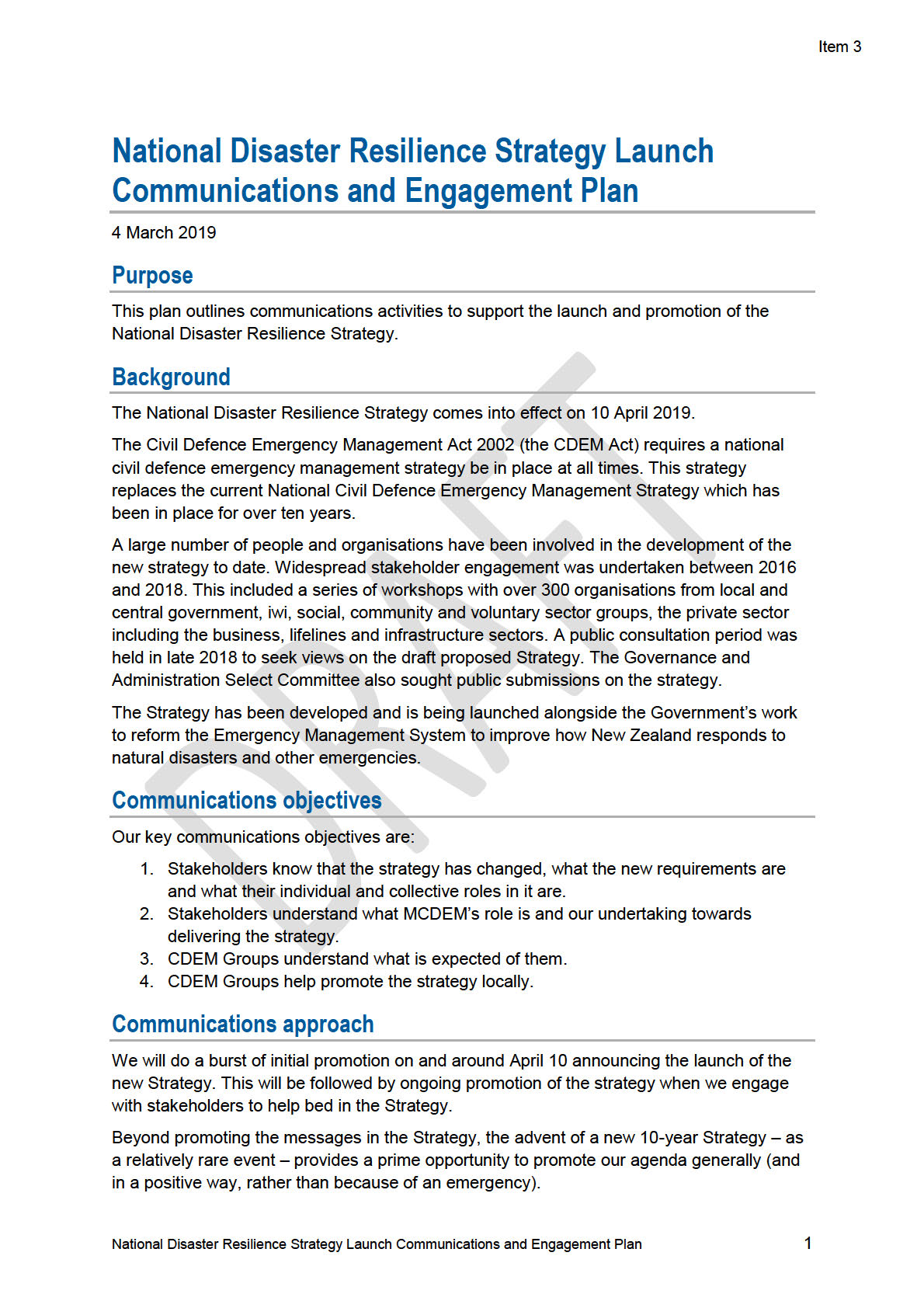
1982
Act
Information
Official
the
under
Released
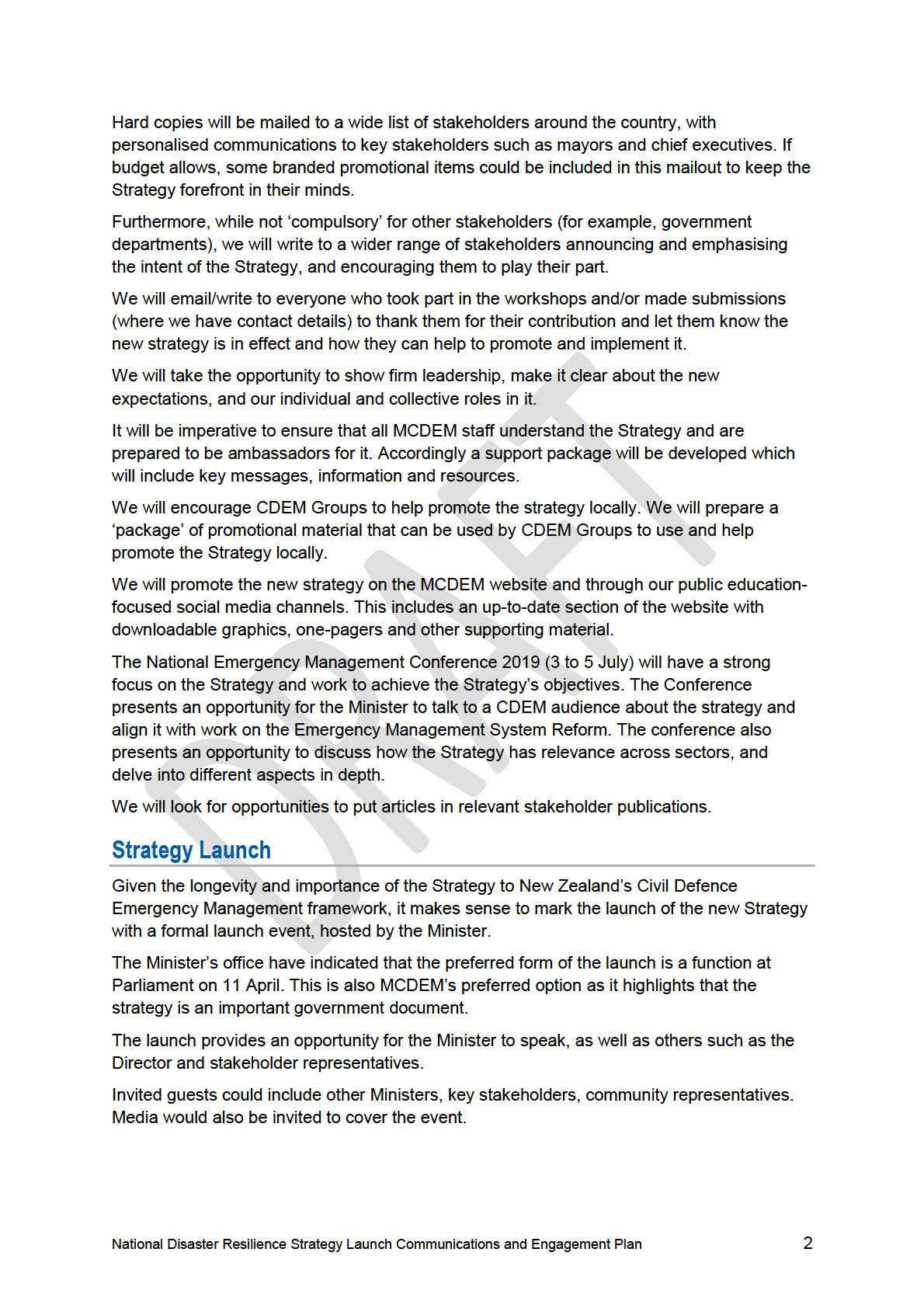
1982
Act
Information
Official
the
under
Released
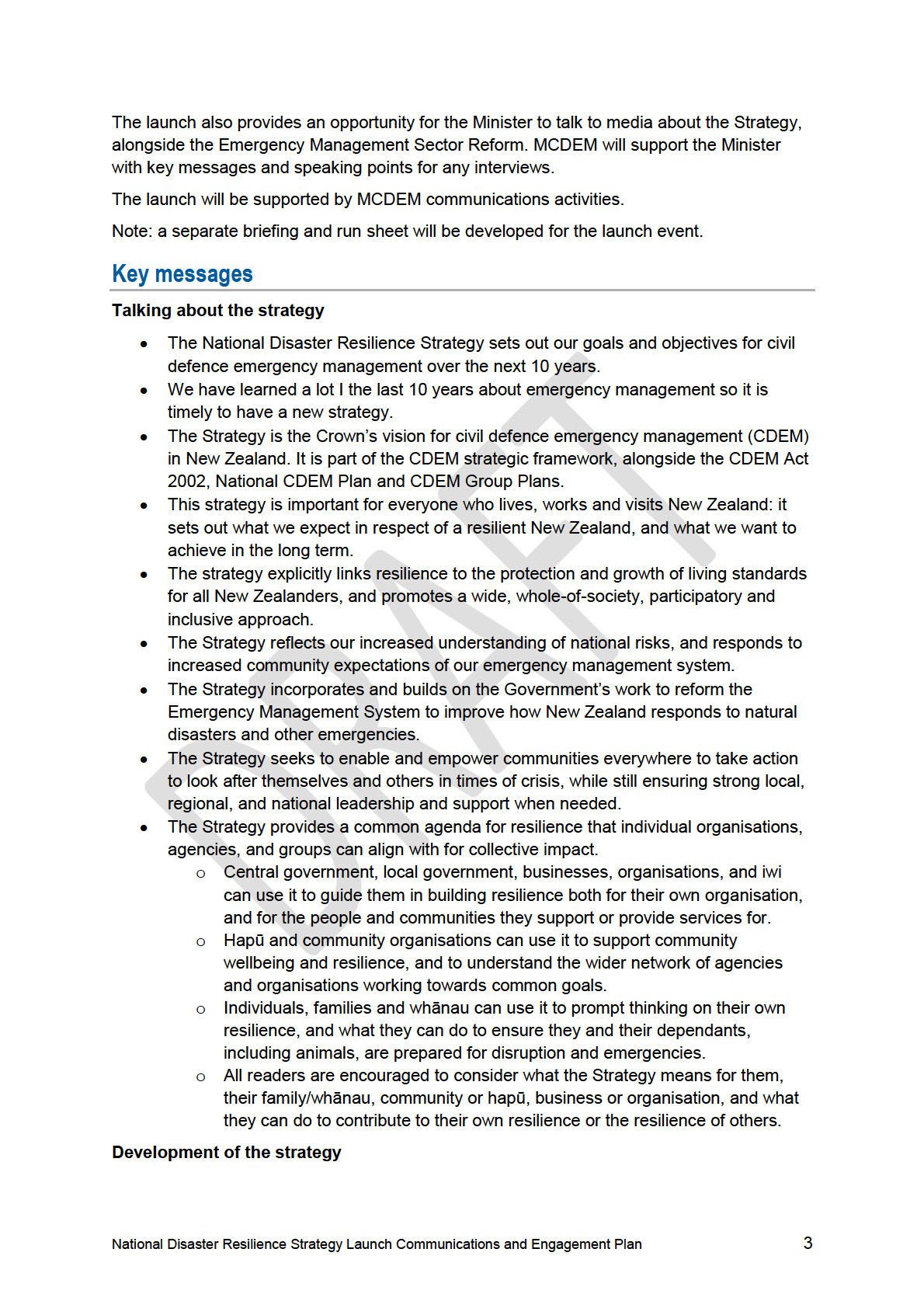
1982
Act
Information
Official
the
under
Released
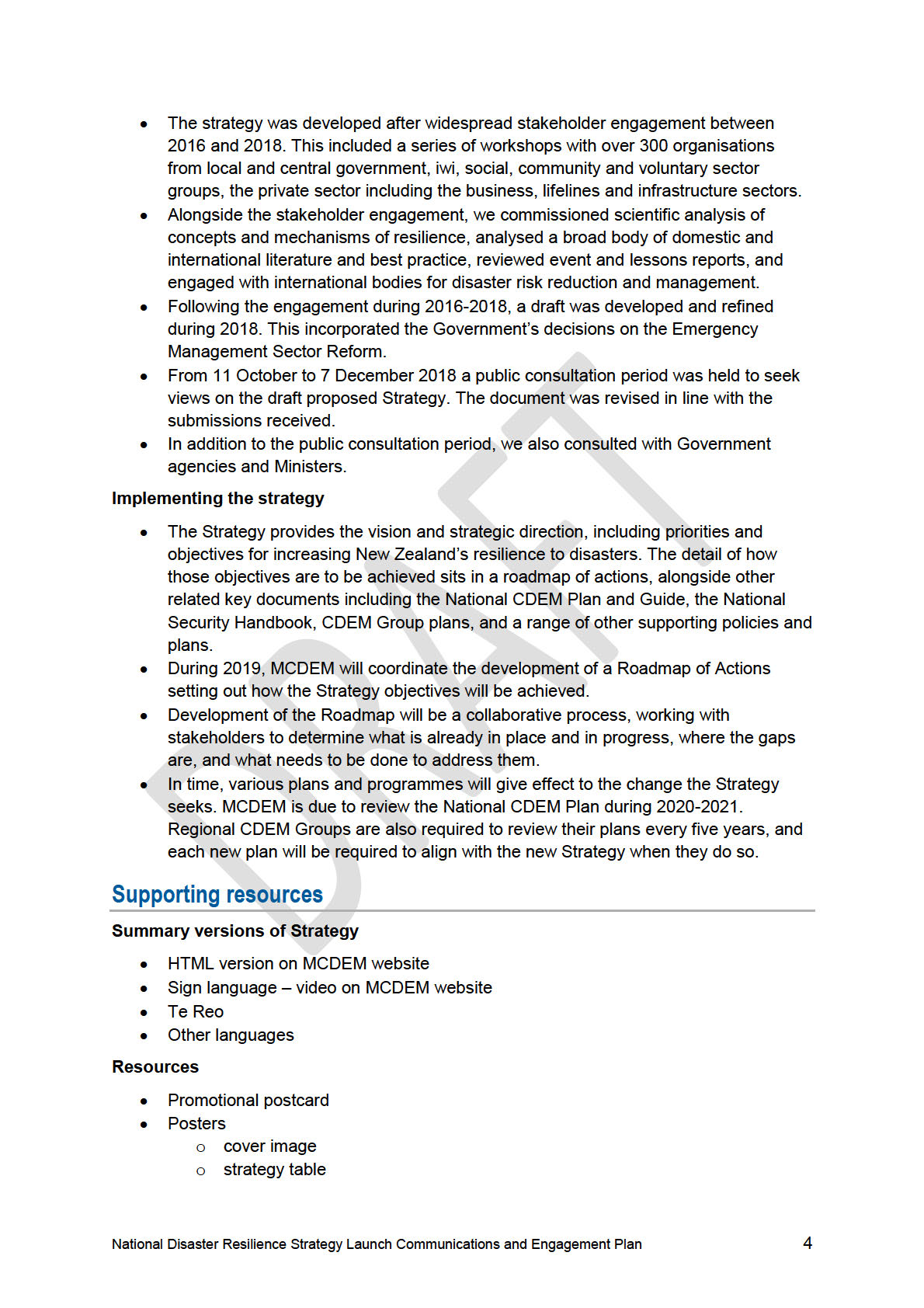
1982
Act
Information
Official
the
under
Released

1982
Act
Information
Official
the
under
Released
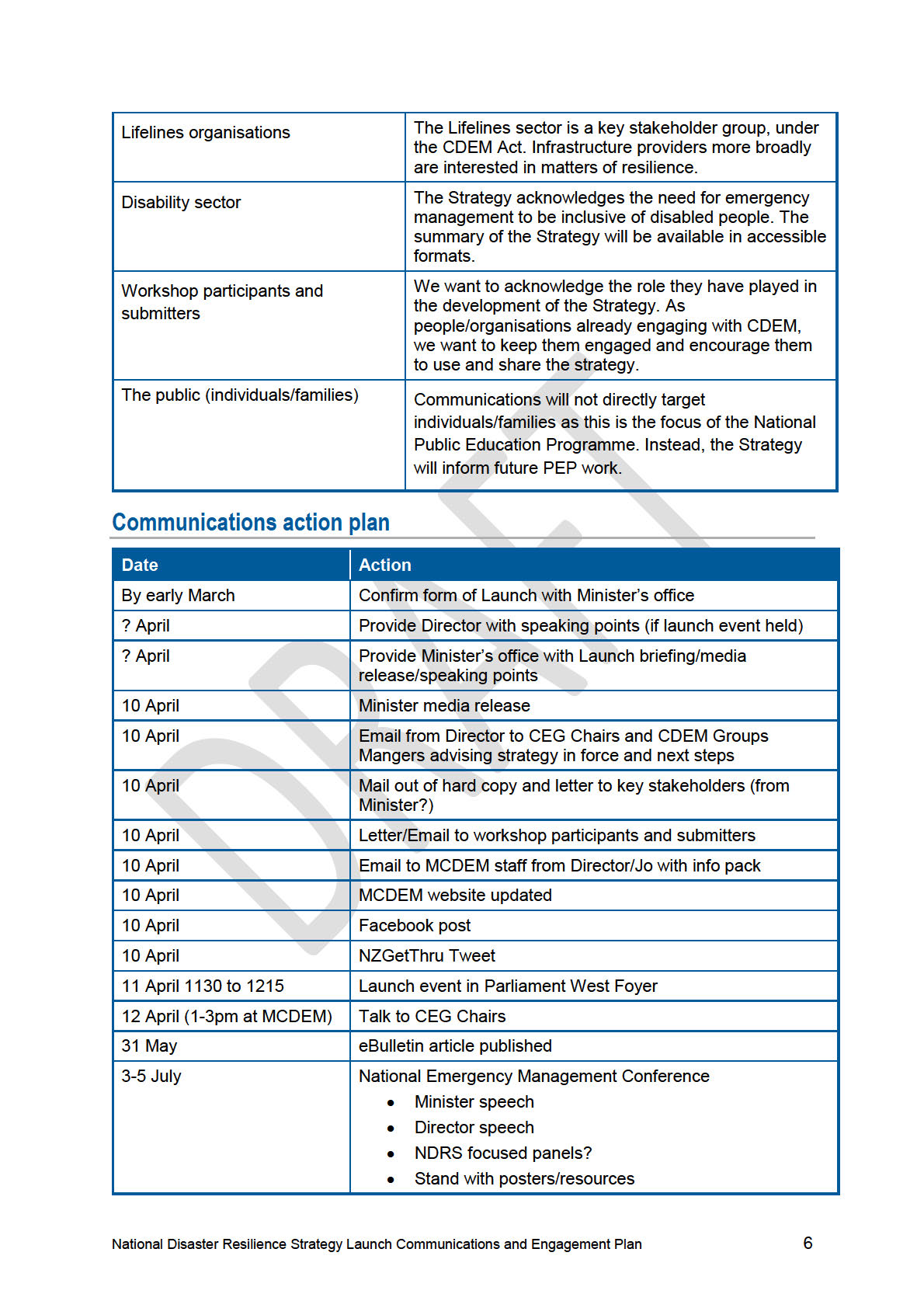
1982
Act
Information
Official
the
under
Released
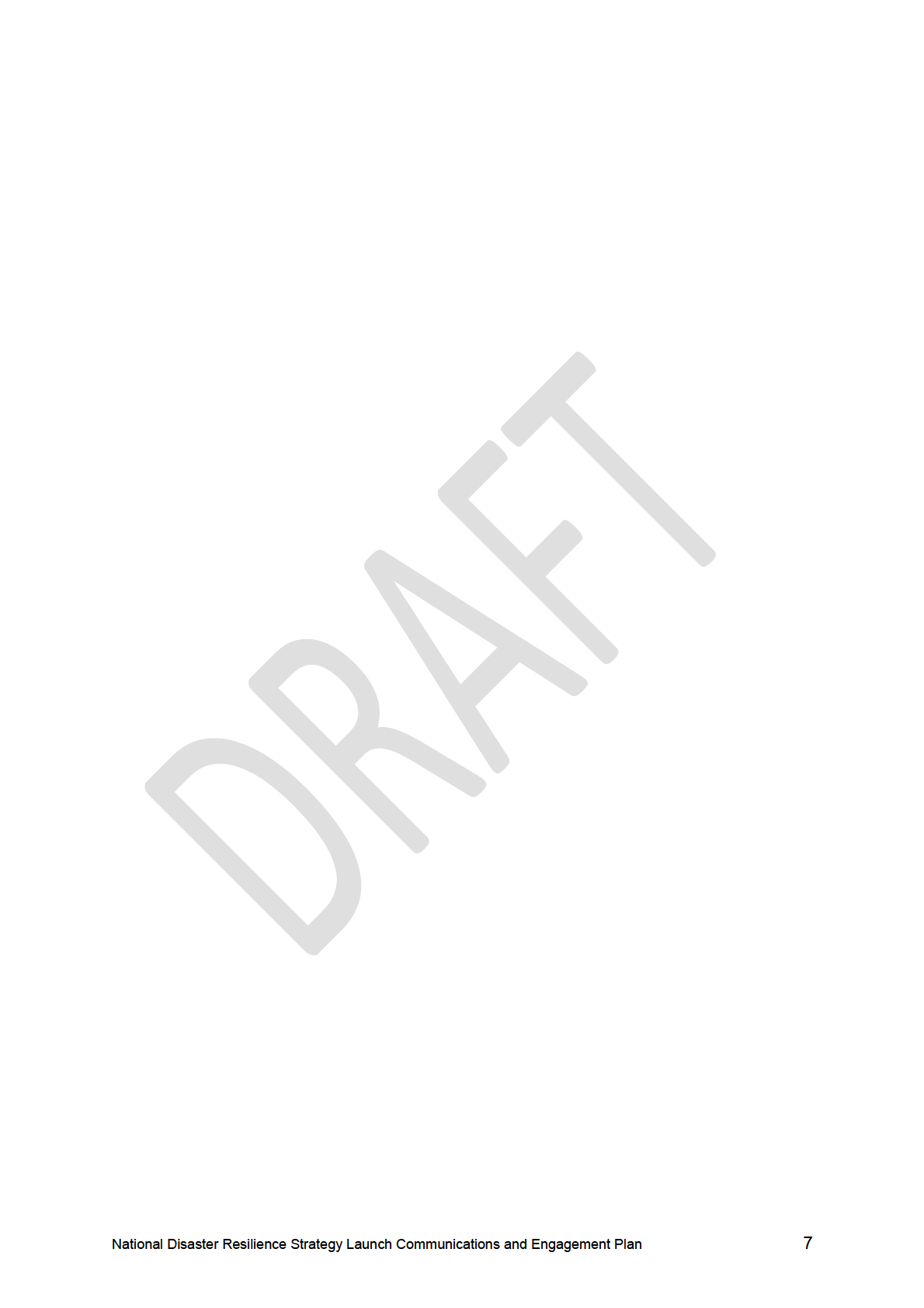
1982
Act
Information
Official
the
under
Released
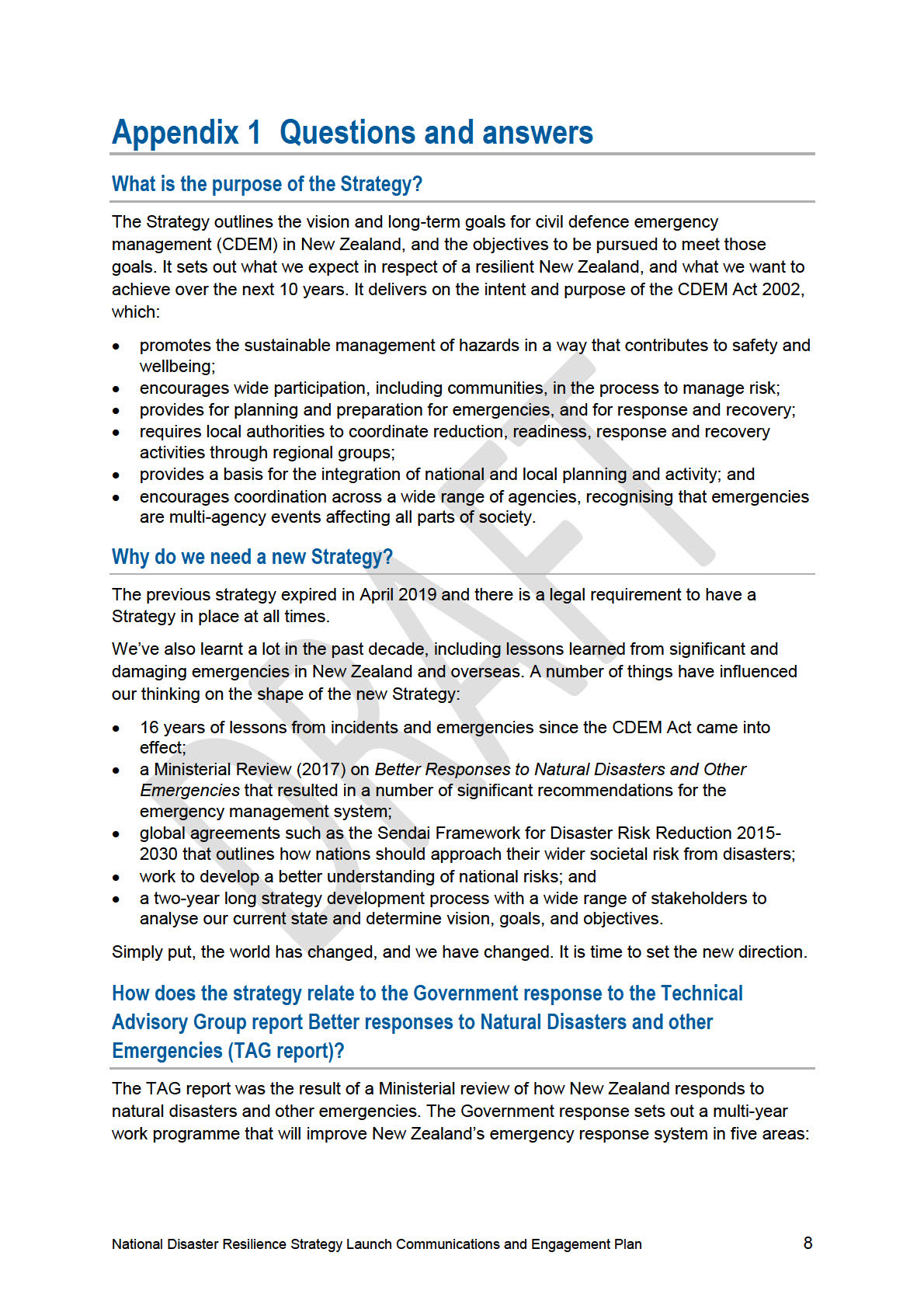
1982
Act
Information
Official
the
under
Released
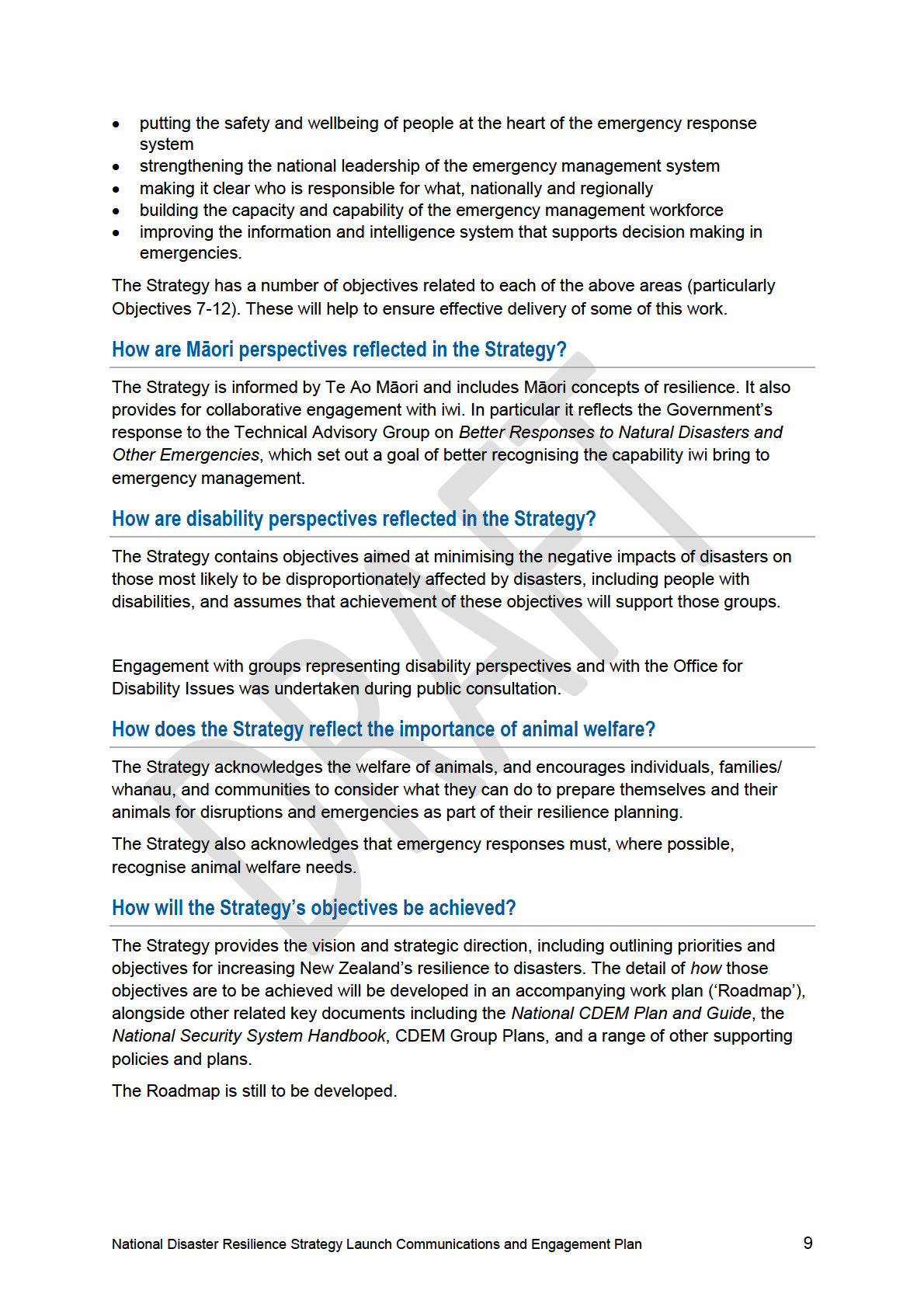
1982
Act
Information
Official
the
under
Released
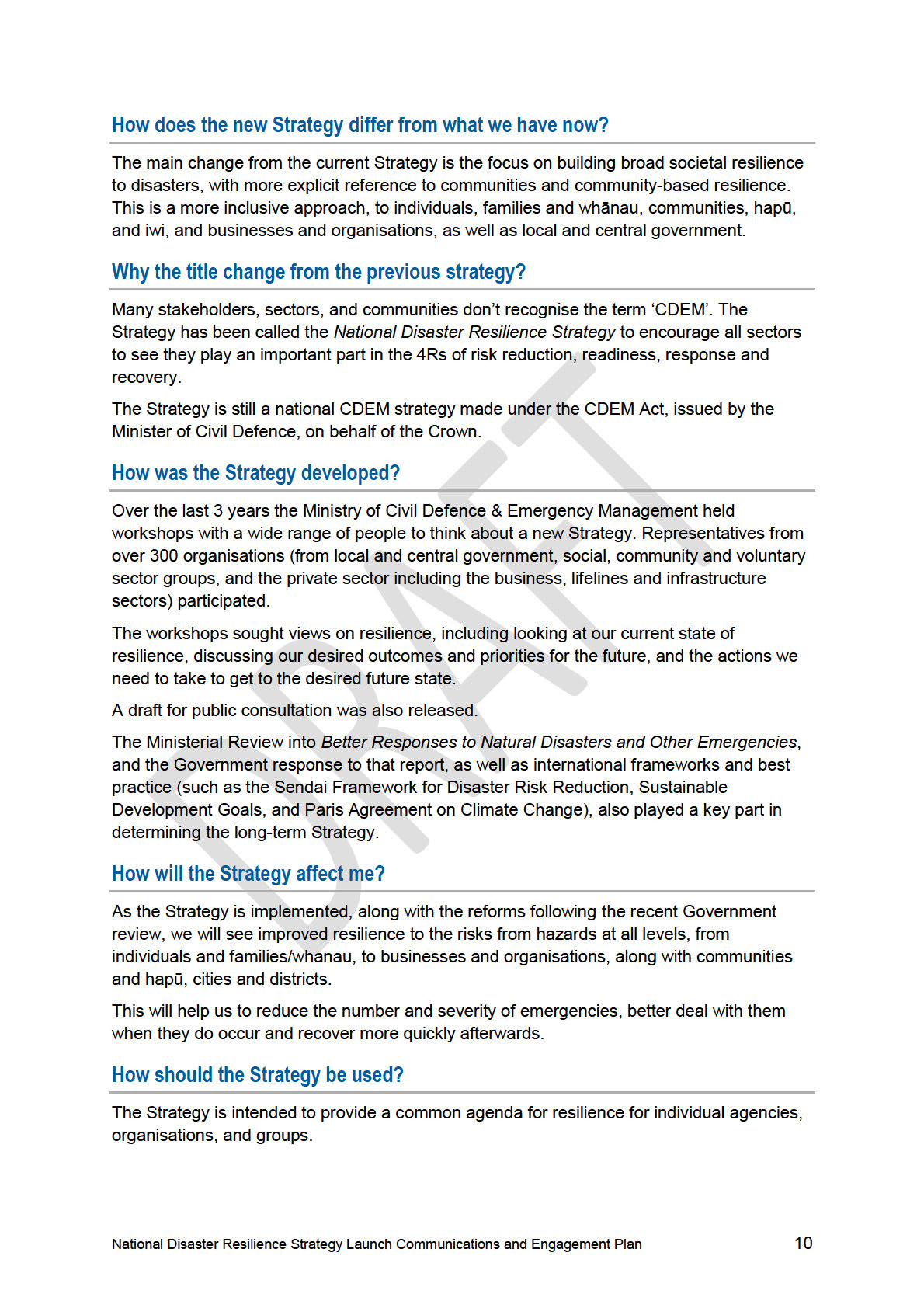
1982
Act
Information
Official
the
under
Released
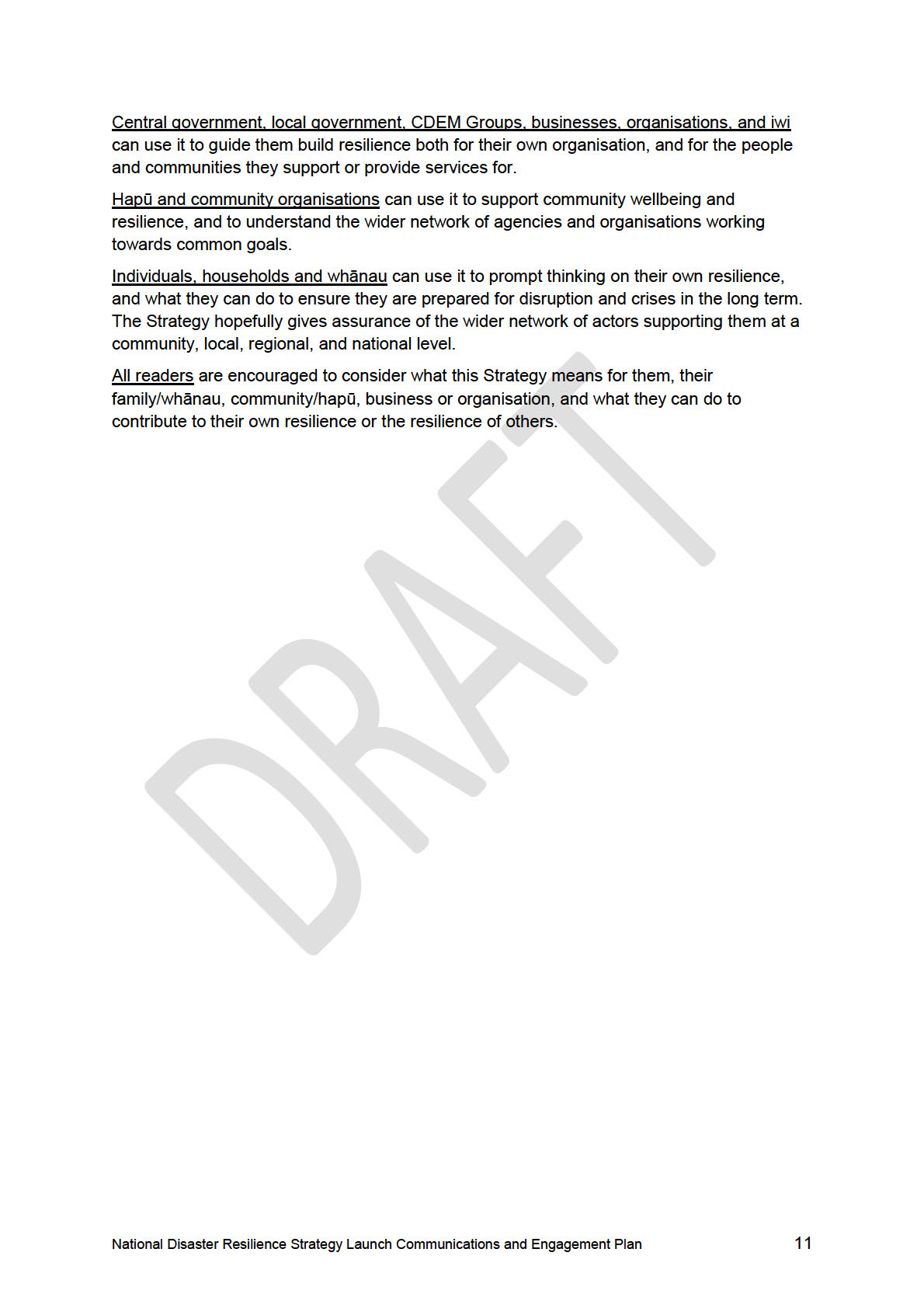
1982
Act
Information
Official
the
under
Released
DRAFT IN CONFIDENCE – AS AT 0820 6/3/19
Item 4
NATIONAL DISASTER RESILIENCE STRATEGY –
VERBAL BRIEFING
Introductory comments
1.
[IF NOT INTRODUCED BY THE CLERK]
• Sarah Stuart-Black, Director CDEM
1982
Some of my team at MCDEM:
• Jo Horrocks, Principal Advisor Emergency Management
• Anthony Richards, Acting Manager, CDEM Policy
Act
• Kathrine Wigley, Senior Advisor CDEM Policy
And our colleagues at Ministry for Primary Industries are here to provide subject-matter
expertise, if needed:
• Dr Kate Littin, Manager, Animal Health
• Wayne Ricketts, National Animal Welfare Coordinator
2.
I’d like to thank the Committee for the opportunity to be here today and brief you on this piece
of work. The Strategy is an extremely significant document for us in the civil defence
emergency management sector, and for the country, as we better manage our risks and
Information
improve our resilience to disasters.
Introduction to the Strategy
3.
You’ll know from the briefing that the Government is legally bound to have a national civil
defence emergency management strategy in place at all times. The Strategy is the Crown’s
Official
vision for CDEM in New Zealand, including its long-term, high-level goals and objectives. It
sits alongside the National CDEM Plan, which is the vehicle for outlining agreed roles,
responsibilities, and arrangements.
the
4.
The current Strategy has been in effect for over 10 years.
5.
We now need a new Strategy – one that reflects the increasing maturity of our approach to
emergency management built from 16 years of lessons since the Act came into effect, work
across government to better understand and manage risk, and the influence of Global
agendas like the United Nations Sendai Framework for Disaster Risk Reduction.
under
Developing a new Strategy
6.
The new strategy has been in development since early 2016.
7.
Early development focussed on building the evidence base and engaging with stakeholders.
We commissioned scientific analysis, analysed domestic and international literature and best
practice, reviewed event and lessons reports, and engaged with international bodies for
disaster risk reduction and management.
Released
8.
We then looked to place that evidence base in a New Zealand context. We undertook a series
of workshops around the country with organisations from local and central government, iwi,
social, community and voluntary sector groups, the private sector including the business,
lifelines and infrastructure sectors. We consulted other government departments on their
policy agendas, and held two national conferences focussed on the future of emergency
management in New Zealand.
9.
Following the engagement during 2016-2018, a draft was developed and refined in parallel
1
DRAFT IN CONFIDENCE – AS AT 0820 6/3/19
with the process to develop the Government’s response to the Ministerial Review report.
10. From 11 October to 7 December 2018 a public consultation period was held to seek views on
the draft proposed Strategy. This was advertised by press release, advertisements in several
national newspapers, in the New Zealand Gazette, on social media, and by email to a wide
range of stakeholders, including all those who had participated in the workshops or
conferences.
11. Seventy-seven submissions were received. The vast majority were of a positive, supportive
nature, while still making a number of constructive suggestions, many of which were taken up
in subsequent revisions.
1982
12. In addition to the public consultation period, we also conducted two periods of agency and
Ministerial consultation (in September 2018 and January 2019). These provided further
refinements; in particular, it ensured the Strategy was well aligned to other portfolio aims and
objectives.
Act
13. We’ve worked hard to consider every submission, and balance a wide range of interests and
to reflect these appropriately in the document. Some submissions weren’t reflected – either
on the basis that they were out of scope, are well catered for by other portfolios, or were too
detailed for a strategic document.
14. Some of the more specific, operational recommendations will go forward to the review of the
National CDEM Plan.
What’s improved in the new Strategy
Information
15. The Strategy is separate from the Technical Advisory Group’s review of the emergency
management system, but many of its objectives are grounded in the Government’s response
to that review.
16. Its focus on resilience and the well-being of people, and its incorporation of Maori perspectives
are key features.
Official
17. The challenges faced by vulnerable communities (particularly those with disabilities or located
in rural areas) and the importance of communities as “first-responders” also emerged as key
themes.
the
18. It also places a stronger emphasis on managing risk, in particular, reducing the underlying
factors that cause the conditions for disaster, and having the best possible information on
which to base decisions about investment and actions.
19. These elements set it apart from its predecessor, and were broadly supported by the public
under
and agency consultation processes.
Implementing the Strategy
20. The Strategy is deliberately high level, with objectives broadly described.
21. During 2019, MCDEM will coordinate the development of a Roadmap of Actions setting out
how the Strategy objectives will be achieved. Its emphasis will be on work to be done over
the next 3-5 years, and will be updated over time, making it a living document.
Released
22. In time, various plans, including the National CDEM Plan, and programmes will give effect to
the Strategy. MCDEM is due to review the National CDEM Plan during 2020-2021. Regional
CDEM Groups are also required to review their plans every five years, and each new plan
will be required to be consistent with the new Strategy when they do so (CDEM Groups are
comprised of local authorities within a regional council boundary, or unitary authorities)
2
DRAFT IN CONFIDENCE – AS AT 0820 6/3/19
Conclusion
23. In summary, we’ve made every effort to ensure the process to develop this strategy was
inclusive and collaborative, and reflects the desires of a broad range of New Zealanders.
24. We think this is a significant evolution for the discipline of emergency management, and that
it will set us on a path for increased resilience in the long term.
25. We know that we will still face hazards, crises, and emergencies, but our hope is that as a
result of this Strategy, more New Zealanders will understand the range of actions to take to
limit impacts and ensure these events do not become disasters that threaten our prosperity
and wellbeing.
1982
Additional: Animal welfare
[SEE ALSO: Q&As]
Act
1.
I’d like to take the opportunity, noting the major theme from the submissions received in
the last week, to add some additional comments on our arrangements for animal welfare.
2.
Animal welfare is an important part of our response to emergencies. We agree with
submitters that:
i.
Animal lives matter.
ii.
Animals are important to people, and some people will risk their lives to rescue
their animals, putting themselves and others at risk.
iii.
There need to be effective plans for animal evacuation and welfare.
Information
iv.
There is room for improvement in our (collective) arrangements for animal
welfare in an emergency, and there have been emergencies where the animal
response was not as rapid or effective as it could have been.
v.
Funding for animal welfare response organisations is a particular issue.
3.
Animal welfare is recognised in the National CDEM Plan and has its own sub-section. The
Official
provisions are based on the principle that all animal owners or persons in charge of
animals should develop their own plans to care for their animals. However, the provisions
also recognise that in an emergency not all animals will be able to be cared for by their
owners, especially in cases of mass evacuation. It also recognises the increasing
the
expectations much of society has come to have on improving animal welfare.
4.
The Plan gives the Ministry for Primary Industries responsibility to co-ordinate the
provision of animal welfare services, coordinate the planning for animal welfare in
emergencies and maintain the Government’s reporting and advisory capability on animal
under
welfare in an emergency. A number of other organisations such as Federated Farmers,
the New Zealand Companion Animal Council and the SPCA are noted as able to provide
support.
5.
Implementation of arrangements in the National CDEM Plan is ongoing (including
addressing funding arrangements) and we continue to work with the Ministry for Primary
Industries and coordinate with support agencies through the national Animal Welfare
Subgroup. Regional level planning for animal welfare in emergencies is progressing with
CDEM Groups.
Released
6.
While animal welfare planning is improving, we acknowledge that more could be done to
develop and agree arrangements. We are continually looking for improvement, as we do
for all our arrangements for response and recovery – we learn from every single event we
have. As such, we will continue to work with partner agencies to support improvements in
animal welfare emergency management through relevant work programmes.
3
DRAFT IN CONFIDENCE – AS AT 0820 6/3/19
7.
The National CDEM Plan will be reviewed in the near future and the matters raised
specific to this regulation will be considered in the review.
1982
Act
Information
Official
the
under
Released
4
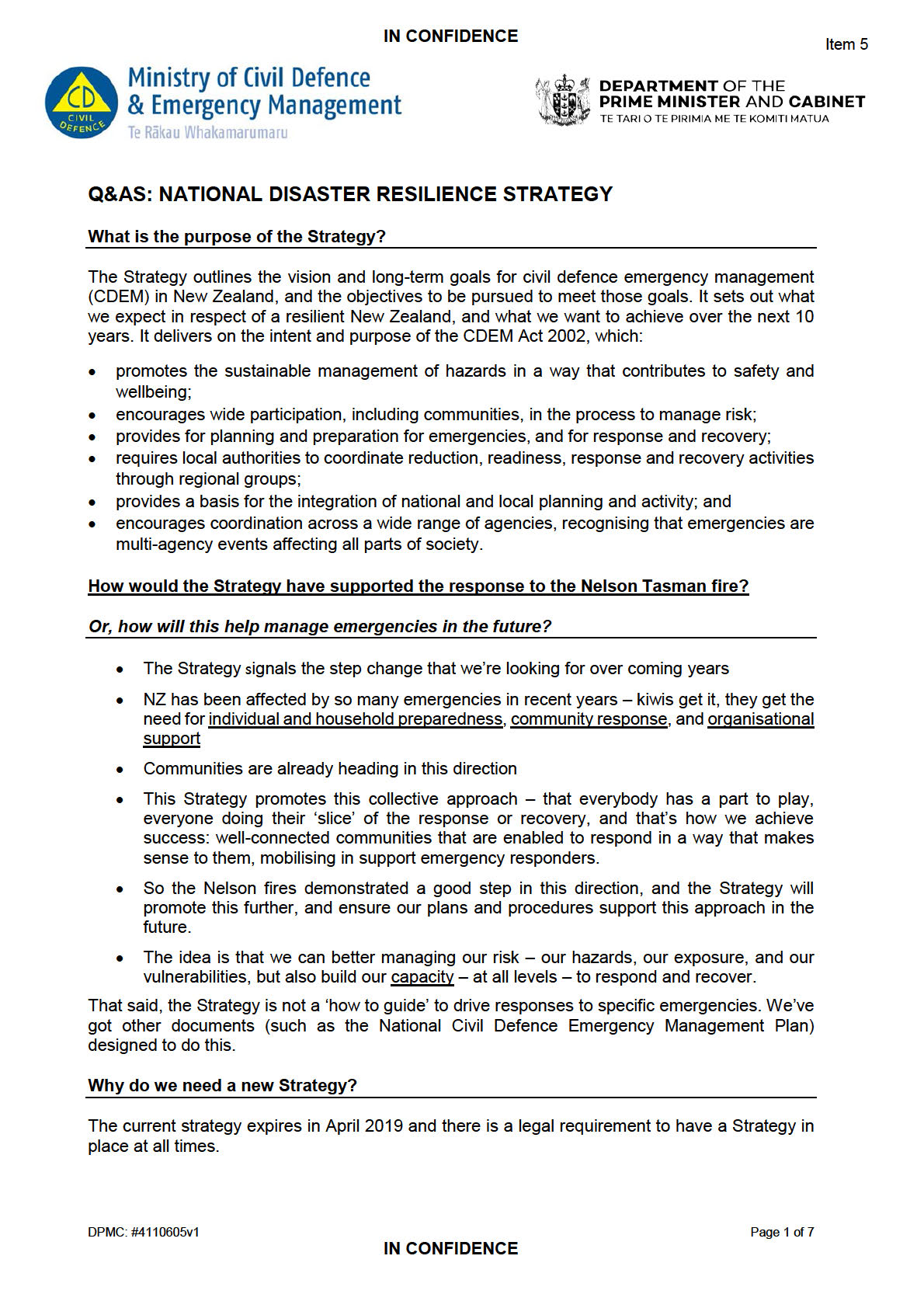
1982
Act
Information
Official
the
under
Released
IN CONFIDENCE
We’ve also learnt a lot in the past decade, including lessons learned from significant and
damaging emergencies in New Zealand and overseas. A number of things have influenced our
thinking on the shape of the new Strategy:
• 16 years of lessons from incidents and emergencies since the CDEM Act came into effect;
• a Ministerial Review (2017) on
Better Responses to Natural Disasters and Other Emergencies
that resulted in a number of significant recommendations for the emergency management
system;
• global agreements such as the Sendai Framework for Disaster Risk Reduction 2015-2030
that outlines how nations should approach their wider societal risk from disasters;
•
1982
work to develop a better understanding of national risks; and
• a two-year long strategy development process with a wide range of stakeholders to analyse
our current state and determine vision, goals, and objectives.
Act
Simply put, the world has changed, and we have changed. It is time to set the new direction.
When will the new Strategy come into effect?
The new Strategy will come into effect on 10 April 2019 unless Parliament resolves before then
not to approve it. It will last for 10 years, although it can be reviewed before then if necessary.
How does the strategy relate to the Government response to the Technical Advisory Group
report Better responses to Natural Disasters and other Emergencies (TAG report)?
Information
The TAG report was the result of a Ministerial review of how New Zealand responds to natural
disasters and other emergencies. The Government response sets out a multi-year work
programme that will improve New Zealand’s emergency response system in five areas:
• putting the safety and wellbeing of people at the heart of the emergency response system
• strengthening the national leadership of the emergency management system
• making it clear who is responsible for what, nationally and regionally
Official
• building the capacity and capability of the emergency management workforce
• improving the information and intelligence system that supports decision making in
emergencies.
the
The Strategy has a number of objectives related to each of the above areas (particularly
Objectives 7-12). These will help to ensure effective delivery of some of this work.
How are Māori perspectives reflected in the Strategy?
under
The Strategy is informed by Te Ao Māori and includes Māori concepts of resilience. It also
provides for collaborative engagement with iwi. In particular it reflects the Government’s response
to the Technical Advisory Group on
Better Responses to Natural Disasters and Other
Emergencies, which set out a goal of better recognising the capability iwi bring to emergency
management.
How are disability perspectives reflected in the Strategy?
Released
The Strategy contains objectives aimed at minimising the negative impacts of disasters on those
most likely to be disproportionately affected by disasters, including people with disabilities, and
assumes that achievement of these objectives will support those groups.
Engagement with groups representing disability perspectives and with the Office for Disability
Issues was undertaken during public consultation.
DPMC: #4110605
Page 2 of 7
IN CONFIDENCE
IN CONFIDENCE
How will the Strategy’s objectives be achieved?
The Strategy provides the vision and strategic direction, including outlining priorities and
objectives for increasing New Zealand’s resilience to disasters. The detail of
how those objectives
are to be achieved will be developed in an accompanying work plan (‘Roadmap’), alongside other
related key documents including the
National CDEM Plan and Guide, the
National Security
System Handbook, CDEM Group Plans, and a range of other supporting policies and plans.
The Roadmap is still to be developed.
How does the new Strategy differ from what we have now?
1982
The main change from the current Strategy is the focus on building broad societal resilience to
disasters, with more explicit reference to communities and community-based resilience. This is a
Act
more inclusive approach, to individuals, families and whānau, communities, hapū, and iwi, and
businesses and organisations, as well as local and central government.
Why the title change from the previous strategy?
Many stakeholders, sectors, and communities don’t recognise the term ‘CDEM’. The Strategy has
been called the
National Disaster Resilience Strategy to encourage all sectors to see they play
an important part in the 4Rs of risk reduction, readiness, response and recovery.
The Strategy is still a national CDEM strategy made under the CDEM Act, issued by the Minister
of Civil Defence, on behalf of the Crown.
Information
How was the Strategy developed?
Over the last 3 years the Ministry of Civil Defence & Emergency Management held workshops
with a wide range of people to think about a new Strategy. Representatives from over 300
organisations (from local and central government, social, community and voluntary sector groups,
Official
and the private sector including the business, lifelines and infrastructure sectors) participated.
The workshops sought views on resilience, including looking at our current state of resilience,
discussing our desired outcomes and priorities for the future, and the actions we need to take to
the
get to the desired future state.
A draft for public consultation was also released.
The Ministerial Review into
Better Responses to Natural Disasters and Other Emergencies, and
the Government response to that report, as well as international frameworks and best practice
under
(such as the Sendai Framework for Disaster Risk Reduction, Sustainable Development Goals,
and Paris Agreement on Climate Change), also played a key part in determining the long-term
Strategy.
The submissions contain criticism that the development process hasn’t been very
extensive. What do you say to this?
Short answer
Released
The process to develop the Strategy began in 2015. This has included wide engagement with
stakeholders, including workshops with over 300 organisations, and a public consultation period
in late 2018.
Long answer
From the beginning (late 2015/early 2016) we identified a strong need to build the evidence base
and engage widely with stakeholders.
DPMC: #4110605
Page 3 of 7
IN CONFIDENCE
IN CONFIDENCE
In terms of ‘evidence’, we commissioned scientific analysis, analysed domestic and international
literature and best practice, reviewed event and lessons reports, and engaged with international
bodies for disaster risk reduction and management.
We then looked to put this in New Zealand context. We undertook a series of workshops around
the country, which were attended by a broad range of stakeholders – far beyond the usual
“emergency management” stakeholders. Attendance included representatives from over 300
organisations - from local and central government, iwi, social, community and voluntary sector
groups, the private sector including the business, lifelines and infrastructure sectors.
We also consulted other government departments on their policy agendas, and held two national
conferences focussed on the future of emergency management in New Zealand.
1982
A public consultation period was held from 11 October to 7 December 2018 held to seek wider
views on the proposed Strategy. This was advertised by press release in several national
newspapers, in the Gazette, on social media, and by email to a wide range of stakeholders,
Act
including all those who had participated in the workshops or conferences.
Seventy-seven submissions were received.
In addition to the public consultation period, we also conducted two periods of agency and
Ministerial consultation (September 2018, and January 2019). These provided further
refinements; in particular, it ensured the Strategy was well aligned to other portfolio aims and
objectives.
In general, people are very positive about the development process, and have noted the efforts
we have made to be inclusive and thorough in our engagement. Of course, it is not possible to
reach everyone. Resourcing and time constraints will limit what we are able to do. But I am
Information
confident this is one of the most comprehensive engagement programmes and collaborative
development processes we have ever run.
How does the Strategy reflect the importance of animal welfare?
The Strategy acknowledges the welfare of animals, and encourages individuals, families/
Official
whanau, and communities to consider what they can do to prepare themselves and their animals
for disruptions and emergencies as part of their resilience planning.
The Strategy also acknowledges that emergency responses must, where possible, recognise
the
animal welfare needs.
The submissions contain criticism that the Strategy is not inclusive of animals. What do
you say to this? under
We agree with submitters that:
• Animal lives matter
• Animals are important to people, and some people will risk their lives to rescue their
animals, putting themselves and others at risk.
• There need to be effective plans for animal evacuation and welfare.
Released
• There is room for improvement in our (collective) arrangements for animal welfare in an
emergency, and there have been emergencies where the animal response was not as
rapid or effective as it could have been.
Improvements in animal welfare during Nelson fires response
DPMC: #4110605
Page 4 of 7
IN CONFIDENCE
IN CONFIDENCE
We note that the response to the Nelson fires was very much improved on previous
emergencies. Evacuated residents still had concerns for their animals, but most animals were
successfully cared for in place, or evacuated and provided shelter in a welfare centre (the latter
looking after around 950 animals at its height). Several organisations, led by the Ministry for
Primary Industries, worked together to check on, feed, evacuate, or care for animals. MPI, as
the lead for animal welfare response, are planning a debrief on the Nelson response, and are
committed to improving and formalising arrangements where necessary.
Inclusion of animals in the Strategy
We have included specific references to animals in the Strategy, where appropriate. These
1982
references are mostly in relation to individuals, households, families, and businesses having
plans and preparedness in place for their animals in case of emergency. We still consider this to
be the most important factor in ensuring good outcomes for animals.
Act
However, we do not believe that animal welfare needs to be a distinct and separate part of the
strategy. We consider animal welfare to be part of "putting people at the centre of the response"
(objective 7), and we would see any corrective actions relating to animal welfare in this section
of the Roadmap of Actions.
This is a matter more suited to a work programme and documented in national, regional, and
local plans, as appropriate (as noted by several submitters).
Animal welfare is recognised and catered for via other plans and guidelines
We have long considered that animal welfare is important and that is why it is recognised in
Information
plans and guidelines.
Animal welfare is recognised in the National CDEM Plan and has its own sub-section. The
provisions are based on the principle that all animal owners or persons in charge of animals
should develop their own plans to care for their animals.
The Plan gives the Ministry for Primary Industries responsibility to co-ordinate the provision of
animal welfare services, coordinate the planning for animal welfare in emergencies and
Official
maintain the Government’s reporting and advisory capability on animal welfare in an
emergency.
the
The need to accommodate evacuees arriving at evacuation centres with pets and planning for
and providing temporary animal shelter is explicitly recognised in the Director’s Guidelines on
mass evacuation planning, and welfare services in an emergency, respectively.
Implementation of arrangements in the National CDEM Plan is ongoing and we continue to work
with the Ministry for Primary Industries and coordinate with support agencies through the
under
national Animal Welfare Subgroup. Regional level planning for animal welfare in emergencies is
progressing with CDEM Groups.
Options to effect change in respect of animal welfare
MCDEM does consider animal welfare to be an area that merits further attention. But it sits
alongside others - including, for example, welfare generally - that are on current and future work
programmes. We consider that these are operational matters, not long-term strategic objectives.
There are multiple upcoming opportunities to effect change in respect of animal welfare,
Released
including:
• Ministry for Primary Industries work programme, and debrief from the Nelson fires
• Regional CDEM Group and local plans
• the Review of the National CDEM Plan (beginning in late 2019)
DPMC: #4110605
Page 5 of 7
IN CONFIDENCE
IN CONFIDENCE
• Additionally, we understand Gareth Hughes MP has a Member's Bill in relation to animal
welfare.
Lastly, I note that Mr Glassey, in his report, "No Animal Left Behind", did not deem the Strategy
needed any action in relation to animal welfare (in amongst otherwise fulsome
recommendations for other instruments).
The submissions contain criticism that the Strategy is not inclusive of rural communities.
What do you say to this?
1982
We agree rural communities are very different from their urban counterparts, and require special
planning, capability and capacity, and communication, in order to meet their particular needs.
That is why we conducted rural specific engagement during the development phase and there is
Act
a specific section on rural communities.
The submissions contain criticism that the Strategy is not inclusive of certain groups of
people. What do you say to this?
We agree that these groups in society require special attention.
The Strategy promotes an inclusive approach to strengthening resilience that recognises
communities aren’t homogenous, or have similar vulnerabilities and capacities.
The Strategy acknowledges that building resilience requires empowerment, and inclusive,
Information
accessible and non-discriminatory participation, paying special attention to people
disproportionately affected by disasters.
The Strategy highlights a few key groups, per popular consensus or policy requirements, but
does not go through all groups in society, as this could become quite exhaustive. This would be
a level of detail that is not appropriate for a strategy.
Official
There are opportunities to include actions relating to specific groups, including:
• Development of the Roadmap of Actions
• the Review of the National CDEM Plan (beginning in late 2019)
the
• Regional CDEM Group and local plans
• Other CDEM Guidelines and documents.
Grey Power / older people
under
We agree with Grey Power’s recommendation that more effort is put into preparedness for NZ
seniors. MCDEM has started a dialogue with Grey Power to this end. Further work needs to be
done. But I can say that we have an article in this month’s Grey Power magazine and we look
forward to working further with Grey Power to improve the preparedness of seniors.
Nurses / health resilience
We agree that
Released
These matters are best addressed by the Ministry of Health
DPMC: #4110605
Page 6 of 7
IN CONFIDENCE
IN CONFIDENCE
What criteria did you use to judge public submissions?
There is a need to keep the size and scope of the Strategy well defined, in order for it to be a
useful, purposeful document. As a result our criteria for analysis was mainly threefold:
• Is the suggestion/recommendation within the scope of the Strategy? (or is it the
substantial focus of other government policy vehicles?)
• Is it of a strategic (versus operational) nature; high level (versus too detailed or too
specific) nature?
• Does the suggestion/recommendation add value to the Strategy? Is it consistent with,
align with, and/or complementary to input to date? (including the vision of the Strategy) 1982
Simply put, there is a need to draw a line somewhere – the Strategy can’t contain everything,
and there are other vehicles for taking other issues forward (for example, The Roadmap, of
Act
Action that will be developed, The National CDEM Plan, regional and local plans, and
Government policy vehicles owned by other agencies).
How will the Strategy affect me?
As the Strategy is implemented, along with the reforms following the recent Government review,
we will see improved resilience to the risks from hazards at all levels, from individuals and
families/whanau, to businesses and organisations, along with communities and hapū, cities and
districts.
This will help us to reduce the number and severity of emergencies, better deal with them when
Information
they do occur and recover more quickly afterwards.
How should the Strategy be used?
The Strategy is intended to provide a common agenda for resilience for individual agencies,
organisations, and groups.
Official
Central government, local government, CDEM Groups, businesses, organisations, and iwi can
use it to guide them build resilience both for their own organisation, and for the people and
communities they support or provide services for.
the
Hapū and community organisations can use it to support community wellbeing and resilience, and
to understand the wider network of agencies and organisations working towards common goals.
Individuals, households and whānau can use it to prompt thinking on their own resilience, and
what they can do to ensure they are prepared for disruption and crises in the long term. The
Strategy hopefully gives assurance of the wider network of actors supporting them at a
under
community, local, regional, and national level.
All readers are encouraged to consider what this Strategy means for them, their family/whānau,
community/hapū, business or organisation, and what they can do to contribute to their own
resilience or the resilience of others.
Released
DPMC: #4110605
Page 7 of 7
IN CONFIDENCE
IN CONFIDENCE
Item 6
Verbal Briefing to GAC
13 MARCH 2019
• Sarah Stuart-Black, Director CDEM
• Jo Horrocks, Principal Advisor Emergency Management
• Anthony Richards, Acting Manager, CDEM Policy
1982
• Kathrine Wigley, Senior Advisor CDEM Policy
And our colleagues at Ministry for Primary Industries are here
Act
to provide subject-matter expertise, if needed:
• Dr Kate Littin, Manager, Animal Health
• Wayne Ricketts, National Animal Welfare Coordinator
1.
The briefing we provided on Monday is an overview of
submissions, and our position on them. It also responds to
questions raised by the Committee on 6 March 2019.
Information
2.
Many of the issues raised by submitters are important to
emergency management. Many are the subject of current work
programmes, or are areas that are earmarked for future work.
The Strategy itself already references many of the issues raised.
Official
3.
118 written submissions were received. Last Wednesday the
Committee heard oral submissions from nine submitters.
the
4.
Animal welfare was the dominant issue amongst submissions.
There were also submissions on the deaf and NZSL community,
older people, rural communities, health sector resilience,
improving data and information, and investment in response
under
capacities, including response teams, an independent
emergency management agency, and international assistance.
5.
I’ll come back to specific submissions in a moment. First I’d like
to cover off a little about the wider CDEM Framework. One of our
main points in the briefing is that the Strategy isn’t necessarily
Released
the right place to progress some of these issues. The Strategy
has an important part in the CDEM framework, to set the long-
term vision and goals, but it can only go so far.
6.
The CDEM framework has a range of instruments that fulfil
DPMC 4117181
Page 1 of 6
IN CONFIDENCE
IN CONFIDENCE
different functions. The CDEM Act 2002 provides statutory
functions; The National CDEM Plan sets out mandated roles and
responsibilities; the Guide to the National CDEM Plan details
arrangements across the ‘4Rs’ of risk reduction, readiness,
response and recovery; CDEM Group Plans provide regional and
local arrangements; and we have a range of guidelines and
technical standards to support specific activities, of which
MCDEM currently maintains over 40.
1982
7.
Some of these are reviewed on a regular basis; others have less
frequent change. A key part of the framework, the National
CDEM Plan and Guide is due to start a significant review later
Act
this year.
8.
In addition to some of these plans and policy, the emergency
management sector is currently undergoing significant reforms,
resulting from the Ministerial Review into
Better Responses to
Natural Disasters and Other Emergencies in New Zealand.
9.
We are also actively debriefing our last response, the Nelson-
Information
Tasman fires, as we do with all emergencies.
10. In all, emergency management, as a discipline, is quite an
‘active’ and dynamic one, which means there is always
opportunity for refining what we do and how we do it.
Official
11. I will now comment on some of the specific areas of interest to
the
submitters.
Animal welfare was the dominant issue amongst
submitters with over 100 submissions.
12. As I mentioned last week, MCDEM agrees with submitters that:
under
• Animal lives matter
• Animals are important to people; and some people will risk
their lives to rescue their animals, putting themselves and
others at risk.
• There needs to be effective plans for animal evacuation and
welfare.
Released
• There is room for improvement in our (collective)
arrangements for animal welfare in an emergency, and there
have been emergencies where the animal response was not
as rapid or effective as it could have been.
DPMC: 4117181
Page 2 of 6
IN CONFIDENCE
IN CONFIDENCE
• Funding for animal welfare response organisations is a
particular issue.
13. Our arrangements for animal welfare in emergencies are already
much improved on where they’ve been in the past. Animal
welfare is recognised in the National CDEM Plan and Guide to
the National CDEM Plan. The Plan gives the Ministry for Primary
Industries responsibility to co-ordinate the provision of animal
welfare services. A number of other organisations provide
1982
support. MPI has a dedicated national animal welfare team who
provide support to regional CDEM Groups for planning, and in
Act
response and recovery.
14. While there will be formal debriefs over coming weeks, the
animal welfare response to the Nelson-Tasman fires was
observably much improved on previous emergencies. Several
organisations, led by MPI, worked together to regularly check on,
feed, evacuate, or care for animals. The Nelson-Tasman
Emergency Coordination Centre was very aware of the need to
Information
allow residents inside the cordon to visit their properties and
animals, and worked hard to facilitate that wherever and
whenever it was safe to do so. The Mayoral Disaster Relief Fund
terms and conditions were amended to enable costs of
organisations providing care for animals to be met.
Official
15. A common concern expressed in the submissions was that
animal owners will break through cordons to rescue their animals
the
or provide for their needs. We recognise this is an issue, and one
that is actually wider than animals alone. In the Nelson-Tasman
fires animals were a key concern; in other emergencies it has
been other things, for example in the Christchurch CBD during
under
the earthquakes there were examples of people breaking the
cordon to rescue important documents and hard drives.
Wherever we put restrictions on movement, there will be people
who want to access that area.
16. For this reason, we have published a ‘Movement Control’
guideline, for managing cordons and other restricted areas. This
Released
was also one of the driving forces for animal welfare to be
included in the National CDEM Plan when it was revised in 2015,
and one of the reasons the Nelson Tasman CDEM Group worked
so hard to implement a temporary access programme during the
DPMC: 4117181
Page 3 of 6
IN CONFIDENCE
IN CONFIDENCE
fires. We know it is important to people and cordon management
will be included in the review of the National CDEM Plan and
Guide.
17. At the same time, cordons are there for a reason – to denote a
significant safety risk. So there is always a balance that needs to
be worked through. But wherever possible, emergency
management organisations will be working to allow access.
18. There is a lot of work underway in animal welfare planning. MPI’s
1982
work plan for 2019 includes work to finalise national and regional
Animal Welfare in Emergency plans, formalising arrangements
Act
with support agencies and national rescue teams, addressing the
gap in legislation on who pays for animal welfare in emergencies,
and creating more public messaging to add to the information
already on its website.
19. The Strategy already has a number of references to animals, and
is enabling of the need to plan for animal welfare. The Strategy is
not the place for further detail, especially any arrangements for
Information
effecting better animal evacuation and welfare. Further progress
will be made by documenting roles, responsibilities, and
arrangements in national and regional/local plans, including
agreeing a funding rationale.
Official
20. Last week we also heard from
Deaf Action with a key message:
the
“If it’s important enough to impart information in English, then it’s
important enough to impart the same information in NZSL”
21. We absolutely agree that accessibility of emergency information
under
for the Deaf community must be a priority. Extensive progress
has been made in the last year towards increasing the use of
NZSL in emergencies, such as an MOU with Deaf Aotearoa,
MCDEM funding the use of interpreters for local emergencies
and the development of NZSL preparedness resources.
22. We agree that the use of an NZSL interpreter in the Nelson-
Released
Tasman fires response was a good example of how NZSL can be
used effectively in an emergency. It is acknowledged that there is
certainly still room for improvement towards making the use of
NZSL interpreters a routine part of every emergency
response. We are working closely with CDEM Groups and other
DPMC: 4117181
Page 4 of 6
IN CONFIDENCE
IN CONFIDENCE
agencies to make this a reality.
23. We have an ongoing and productive dialogue with Deaf Action
and we look forward to working together to identify ongoing
opportunities for improvement.
24. I’ll mention a couple of other areas briefly, then leave the rest of
the time for questions.
25. Last week we also heard from the
NZ Nurses Organisation. A 1982
couple of points really stood out. We heard that:
“Currently many
areas in the Health system are working at the limits of capacity
so there is little opportunity to incorporate resilience or ‘tolerance
Act
for disruption’’; they also noted that
“Further discussion is
required to establish what ‘health’ in a resilient nation looks like”.
26. These are important points: we totally agree that people’s health,
and the resilience of the health sector is important for New
Zealand’s overall resilience. The Strategy already recognises this
in several ways, in some of the contextual narrative and
diagrams, and this will definitely warrant further discussion as we
Information
go forward.
27. In terms of the Strategy though, we can’t go into detail in every
area. We have stated that in order to keep the scope of the
Strategy defined and manageable, we have ring-fenced it to the
Official
disaster aspects of resilience, and have not gone too far into
other portfolio areas that are already well catered for by policy
the
and practice.
28. It’s an important discussion though, and we will certainly take this
up with health sector agencies as we look to implement the
Strategy. under
29. We also heard from representatives of
Grey Power New
Zealand, who made some important observations about the
need to tailor preparedness messages for seniors.
30. We agree that older people, and other groups in society, require
Released
special attention. The Strategy promotes an inclusive approach
to strengthening resilience that recognises communities aren’t
homogenous; different subsets and groups have different
vulnerabilities and capacities.
DPMC: 4117181
Page 5 of 6
IN CONFIDENCE
IN CONFIDENCE
31. The Strategy also promotes a strengths-based approach,
recognising that many people and groups who face challenges in
their everyday lives, also have tremendous capacity and
capability. A participatory approach can enable, empower people
who might otherwise be disproportionately affected. It can also
add to the richness and effectiveness of emergency management
planning, and ensure the outcomes from disasters are as
equitable as possible.
1982
32. We have recently been working with Grey Power to promote
emergency preparedness among seniors, and have made
contact with the Office for Seniors to see if there are areas wher
Act e
we could collaborate further.
33.
In conclusion, we recognise the range of issues raised by
submitters. We agree with many of them, and are already taking
action on them in our plans and work programmes.
34. The Strategy references many of the issues raised. We do not
Information
believe they need to be further detailed in the Strategy. This a
long-term strategy, not a detailed plan. Other vehicles, such as
the National CDEM Plan, Guide to the National CDEM Plan, and
regional/local plans are more appropriate for setting out roles,
Official
responsibilities, and arrangements.
35. Thank you for the opportunity to comment and I’m happy to take
the
any questions.
under
Released
DPMC: 4117181
Page 6 of 6
IN CONFIDENCE
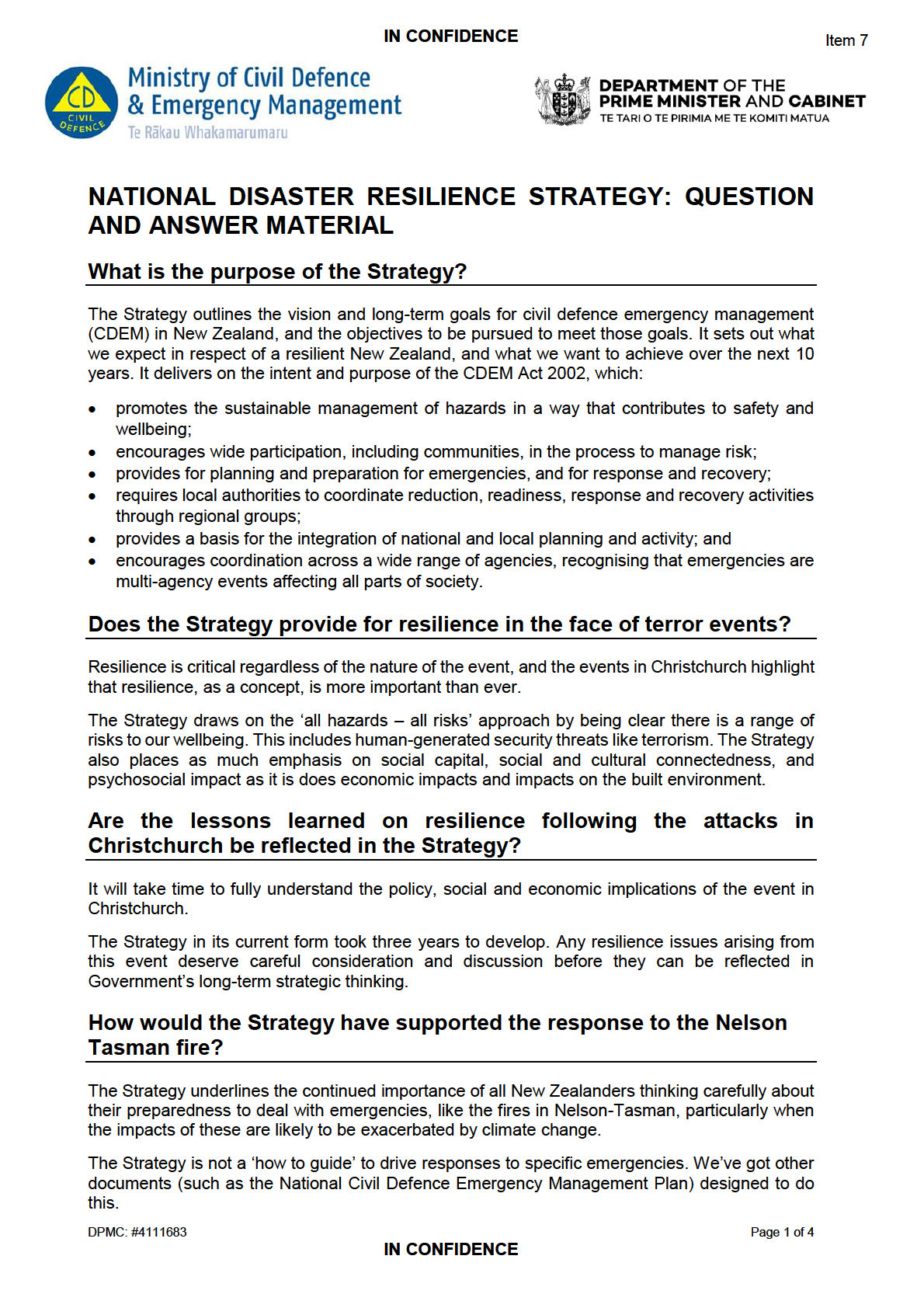
1982
Act
Information
Official
the
under
Released
IN CONFIDENCE
Why do we need a new Strategy?
The current strategy expires in April 2019 and there is a legal requirement to have a Strategy in
place at all times.
We’ve also learnt a lot in the past decade, including lessons learned from significant and
damaging emergencies in New Zealand and overseas. A number of things have influenced our
thinking on the shape of the new Strategy:
16 years of lessons from incidents and emergencies since the CDEM Act came into effect;
a Ministerial Review (2017) on
Better Responses to Natural Disasters and Other Emergencies 1982
that resulted in a number of significant recommendations for the emergency management
system;
global agreements such as the Sendai Framework for Disaster Risk Reduction 2015-2030
Act
that outlines how nations should approach their wider societal risk from disasters;
work to develop a better understanding of national risks; and
a two-year long strategy development process with a wide range of stakeholders to analyse
our current state and determine vision, goals, and objectives.
Simply put, the world has changed, and we have changed. It is time to set the new direction.
When will the new Strategy come into effect?
The new Strategy will come into effect on 10 April 2019 unless Parliament resolves before then
Information
not to approve it. It will last for 10 years, although it can be reviewed before then if necessary.
How does the strategy relate to the Government response to the
Technical Advisory Group report Better responses to Natural Disasters
and other Emergencies (TAG report)?
Official
The TAG report was the result of a Ministerial review of how New Zealand responds to natural
disasters and other emergencies. The Government response sets out a multi-year work
programme that wil improve New Zealand’s emergency response system in five areas:
the
putting the safety and wellbeing of people at the heart of the emergency response system
strengthening the national leadership of the emergency management system
making it clear who is responsible for what, nationally and regionally
building the capacity and capability of the emergency management workforce
under
improving the information and intelligence system that supports decision making in
emergencies.
The Strategy has a number of objectives related to each of the above areas (particularly
Objectives 7-12). These will help to ensure effective delivery of some of this work.
How are Māori perspectives reflected in the Strategy?
The Strategy is informed by Te Ao Māori and includes Māori concepts of resilience. It also
Released
provides for collaborative engagement with iwi. In particular it reflects the Government’s response
to the Technical Advisory Group on
Better Responses to Natural Disasters and Other
Emergencies, which set out a goal of better recognising the capability iwi bring to emergency
management.
How are disability perspectives reflected in the Strategy?
DPMC: #4111683
Page 2 of 4
IN CONFIDENCE
IN CONFIDENCE
The Strategy contains objectives aimed at minimising the negative impacts of disasters on those
most likely to be disproportionately affected by disasters, including people with disabilities, and
assumes that achievement of these objectives will support those groups.
Engagement with groups representing disability perspectives and with the Office for Disability
Issues was undertaken during public consultation.
How does the Strategy reflect the importance of animal welfare?
The Strategy acknowledges the welfare of animals, and encourages individuals, families/
whanau, and communities to consider what they can do to prepare themselves and their animals
1982
for disruptions and emergencies as part of their resilience planning.
The Strategy also acknowledges that emergency responses must, where possible, recognise
Act
animal welfare needs.
How will the Strategy’s objectives be achieved?
The Strategy provides the vision and strategic direction, including outlining priorities and
objectives for increasing New Zealand’s resilience to disasters. The detail of
how those objectives
are to be achieved will be developed in an accompanying work plan (‘Roadmap’), alongside other
related key documents including the
National CDEM Plan and Guide, the
National Security
System Handbook, CDEM Group Plans, and a range of other supporting policies and plans.
The Roadmap is still to be developed.
Information
How does the new Strategy differ from what we have now?
The main change from the current Strategy is the focus on building broad societal resilience to
disasters, with more explicit reference to communities and community-based resilience. This is a
more inclusive approach, to individuals, families and whānau, communities, hapū, and iwi, and
Official
businesses and organisations, as well as local and central government.
Why the title change from the previous strategy?
the
Many stakeholders, sectors, and communities don’t recognise the term ‘CDEM’. The Strategy has
been called the
National Disaster Resilience Strategy to encourage all sectors to see they play
an important part in the 4Rs of risk reduction, readiness, response and recovery.
The Strategy is still a national CDEM strategy made under the CDEM Act, issued by the Minister
under
of Civil Defence, on behalf of the Crown.
How was the Strategy developed?
Over the last 3 years the Ministry of Civil Defence & Emergency Management held workshops
with a wide range of people to think about a new Strategy. Representatives from over 300
organisations (from local and central government, social, community and voluntary sector groups,
and the private sector including the business, lifelines and infrastructure sectors) participated.
Released
The workshops sought views on resilience, including looking at our current state of resilience,
discussing our desired outcomes and priorities for the future, and the actions we need to take to
get to the desired future state.
A draft for public consultation was also released.
The Ministerial Review into
Better Responses to Natural Disasters and Other Emergencies, and
the Government response to that report, as well as international frameworks and best practice
DPMC: #4111683
Page 3 of 4
IN CONFIDENCE
IN CONFIDENCE
(such as the Sendai Framework for Disaster Risk Reduction, Sustainable Development Goals,
and Paris Agreement on Climate Change), also played a key part in determining the long-term
Strategy.
How will the Strategy affect me?
As the Strategy is implemented, along with the reforms following the recent Government review,
we will see improved resilience to the risks from hazards at all levels, from individuals and
families/whanau, to businesses and organisations, along with communities and hapū, cities and
districts.
1982
This will help us to reduce the number and severity of emergencies, better deal with them when
they do occur and recover more quickly afterwards.
Act
How should the Strategy be used?
The Strategy is intended to provide a common agenda for resilience for individual agencies,
organisations, and groups.
Central government, local government, CDEM Groups, businesses, organisations, and iwi can
use it to guide them build resilience both for their own organisation, and for the people and
communities they support or provide services for.
Hapū and community organisations can use it to support community wellbeing and resilience, and
to understand the wider network of agencies and organisations working towards common goals.
Information
Individuals, households and whānau can use it to prompt thinking on their own resilience, and
what they can do to ensure they are prepared for disruption and crises in the long term. The
Strategy hopefully gives assurance of the wider network of actors supporting them at a
community, local, regional, and national level.
All readers are encouraged to consider what this Strategy means for them, their family/whānau,
community/hapū, business or organisation, and what they can do to contribute to their own
Official
resilience or the resilience of others.
the
under
Released
DPMC: #4111683
Page 4 of 4
IN CONFIDENCE
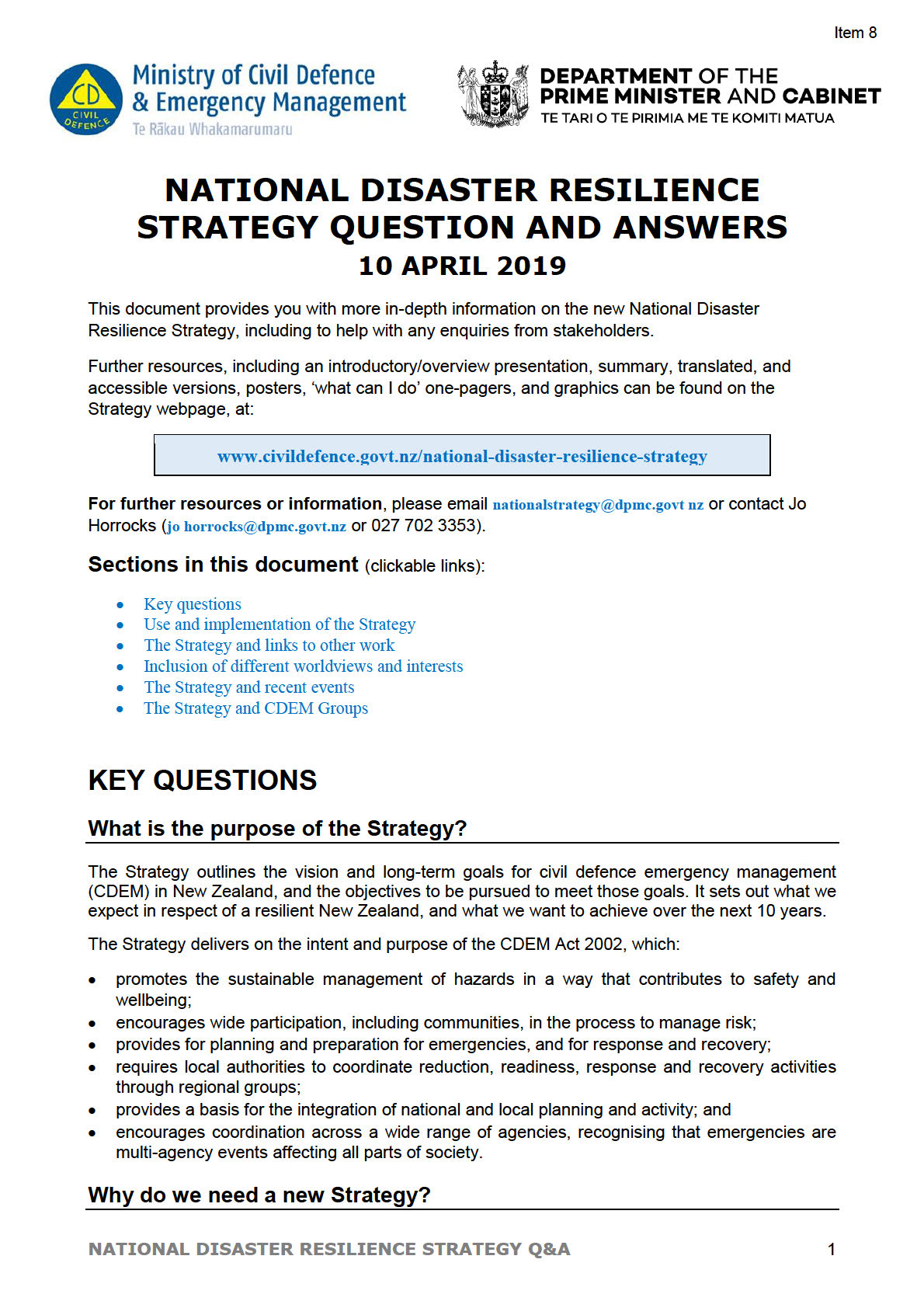
1982
Act
Information
Official
the
under
Released
The previous strategy expired on 9 April 2019 and there is a legal requirement to have a Strategy in
place at all times.
We’ve also learnt a lot in the past decade, including lessons learned from significant and damaging
emergencies in New Zealand and overseas. A number of things have influenced our thinking on the
shape of the new Strategy:
16 years of lessons from incidents and emergencies since the CDEM Act came into effect;
a Ministerial Review (2017) on
Better Responses to Natural Disasters and Other Emergencies
that resulted in a number of significant recommendations for the emergency management
system;
1982
global agreements such as the Sendai Framework for Disaster Risk Reduction 2015-2030 that
outlines how nations should approach their wider societal risk from disasters;
work to develop a better understanding of national risks; and
Act
a two-year long strategy development process with a wide range of stakeholders to analyse our
current state and determine vision, goals, and objectives.
Simply put, the world has changed, and we have changed. It is time to set the new direction.
How does the new Strategy differ from the previous one?
The main change from the current Strategy is the focus on building broad societal resilience to
disasters, with more explicit reference to communities and community-based resilience. This is a
more inclusive approach, to individuals, families and whānau, communities, hapū, and iwi, and
businesses and organisations, as well as local and central government.
Information
Why the title change from the previous strategy?
Many stakeholders, sectors, and communities don’t recognise the term ‘CDEM’. The Strategy has
been called the
National Disaster Resilience Strategy to encourage all sectors to see they play an
important part in the 4Rs of risk reduction, readiness, response and recovery.
Official
The Strategy is still a national CDEM strategy made under the CDEM Act, issued by the Minister of
Civil Defence, on behalf of the Crown.
the
How was the Strategy developed?
From the beginning of the Strategy development process (late 2015/early 2016), we identified a
strong need to build the evidence base and engage widely with stakeholders.
In terms of ‘evidence’, we commissioned scientific analysis, analysed domestic and international
under
literature and best practice, reviewed event and lessons reports, and engaged with international
bodies for disaster risk reduction and management.
We then looked to put this in New Zealand context. We undertook a series of workshops around the
country, which were attended by a broad range of people and groups. Attendance included
representatives from over 300 organisations - from local and central government, iwi, social,
community and voluntary sector groups, the private sector including the business, lifelines and
infrastructure sectors. We also consulted other government departments on their policy agendas,
and held two national conferences focussed on the future of emergency management in New
Released
Zealand.
The Ministerial Review into
Better Responses to Natural Disasters and Other Emergencies, and the
Government response to that report, as well as international frameworks and best practice (such as
the Sendai Framework for Disaster Risk Reduction, Sustainable Development Goals, and Paris
Agreement on Climate Change), played a key part in determining the Strategy.
NATIONAL DISASTER RESILIENCE STRATEGY Q&A
2
A public consultation period was held from 11 October to 7 December 2018 to seek wider views on
the proposed Strategy. This was advertised by press release, advertisements in several national
newspapers, in the New Zealand Gazette, on social media, and by email to a wide range of
stakeholders, including all those who had participated in the workshops or conferences.
In addition to the public consultation period, we also conducted two periods of agency and Ministerial
consultation (September 2018, and January 2019). These provided further refinements; in particular,
it ensured the Strategy was well aligned to other portfolio aims and objectives.
Finally, the Strategy was referred to the Governance and Administration (Select) Committee for their
review. The Governance and Administration Committee held a one-week public consultation period
to seek their own independent views on the Strategy, and subsequently reported their approval to
1982
the House of Representatives.
How will the Strategy affect me?
Act
As the Strategy is implemented, along with the reforms following the recent Government review, we
will see improved resilience to the risks from hazards at all levels, from individuals and
families/whanau, to businesses and organisations, along with communities and hapū, cities and
districts.
This will help us to reduce the number and severity of emergencies, better deal with them when they
do occur and recover more quickly afterwards.
You can also contribute! Everyone is encouraged to consider what the Strategy means for them,
their family/whānau, community/hapū, business or organisation, and what they can do to contribute
Information
to their own resilience or the resilience of others.
Why doesn’t the Strategy tell me what to do?
The purpose of the Strategy is to provide long-term, high-level goals and objectives in order to
achieve an overarching vision (in this case, a disaster resilient nation). It is not a plan for response
Official
or recovery, a corrective action plan, or a work programme.
The Strategy provides the ‘why’ and, broadly, the ‘how’. However, it does not provide the ‘how to’ or
‘what’, address specific issues, or aim to drive specific responses to emergencies. This is more
the
appropriately provided in other documents such as the National CDEM Plan, local plans, or a range
of guidance material specifically designed to support action.
under
Released
NATIONAL DISASTER RESILIENCE STRATEGY Q&A
3
USE AND IMPLEMENTATION OF THE STRATEGY
What are the next steps?
We know that, as the document itself says, a strategy is not the end of thinking about resilience, it’s
the beginning. So when the Strategy comes into effect, the hard work starts.
Collectively, at a central and local government level, in the public and private sectors, and in our
communities, we are already progressing work that will contribute to a number of objectives of the
Strategy.
1982
An early task is to produce a formal implementation plan, which the document calls a ‘Roadmap of
Actions’. This will look at the desired end state for each objective, examine what we already have in
place and in progress, and define what the gap is. We can then programme work to fill the gaps.
Act
Another key task is completing the measuring, monitoring, and evaluation regime that accompanies
the Strategy. This will be a key part of our accountability, and ensuring we stay on track and monitor
progress and effectiveness.
MCDEM also intends to work on a series of resources and toolboxes to help others implement their
part in the Strategy.
In all, we intend to ensure that – collectively – we make progress on the vision of this document, and
that New Zealand becomes a more disaster resilient nation.
How will the Strategy be implemented?
Information
The Strategy provides the vision and strategic direction, including outlining priorities and objectives
for increasing New Zealand’s resilience to disasters. The detail of
how those objectives are to be
achieved will be developed in an accompanying work plan (‘Roadmap of Actions’), alongside other
related key documents including the
National CDEM Plan and Guide, the
National Security System
Handbook, CDEM Group Plans, and a range of other supporting policies and plans.
Official
MCDEM will coordinate the development of the Roadmap of Actions during 2019.
This said, the Strategy is intended to provide
a common agenda for resilience that individual
the
agencies, organisations, and groups can align with for collective impact.
Everyone is encouraged to read the Strategy and consider what it means for them, their
family/whānau, community/hapū, business, organisation, or CDEM Group, and what they can do to
contribute to their own resilience or the resilience of others.
under
Who owns the Strategy?
The Strategy is issued by the Minister of Civil Defence (pursuant to s 31 of the CDEM Act 2002) and
provides an outline of the ‘Crown’s goals’ in relation to civil defence emergency management.
However, the Strategy is
for all New Zealanders, and all those who live, work or visit here. It was
developed collaboratively so that it reflects our collective realities, and with the intention that we all
feel a sense of ownership for it.
Released
MCDEM and CDEM Groups have a particular responsibility – statutorily – to be “not inconsistent”
with the Strategy in undertaking their activities and planning.
Those who work in emergency management, or in a risk or resilience-related field generally,
are particularly encouraged to promote the messages in the Strategy, and drive progress on the
goals and objectives.
NATIONAL DISASTER RESILIENCE STRATEGY Q&A
4
How will the Strategy be measured and monitored?
An intended measuring and monitoring framework is described in the Strategy (page 35-36). This
will be further developed during 2019 (with the Roadmap of Actions), and detailed in an
accompanying document.
The intention is for a suite of indicators that measure, monitor, and report on:
progress on goals and objectives;
progress on resilience; and
progress on impact.
1982
How should the Strategy be used?
Act
The Strategy is intended to provide a common agenda for resilience for individual agencies,
organisations, and groups.
Central government, local government, CDEM Groups, businesses, organisations, and iwi can use
the Strategy to guide them build resilience both for their own organisation, and for the people and
communities they support or provide services for.
Hapū and community organisations can use the Strategy to support community wellbeing and
resilience, and to understand the wider network of agencies and organisations working towards
common goals.
Individuals, households and whānau can use the Strategy to prompt thinking on their own resilience,
and what they can do to ensure they are prepared for disruption and crises in the long term. The
Information
Strategy hopefully gives assurance of the wider network of actors supporting them at a community,
local, regional, and national level.
All readers are encouraged to consider what the Strategy means for them, their family/whānau,
community/hapū, business or organisation, and what they can do to contribute to their own resilience
or the resilience of others.
Official
The Strategy contains tailored recommendations for each of these groups, and they are available
for individual download on the Strategy website (
civildefence.govt.nz/national-disaster-resilience-strategy) – along with a host of other resources.
the
under
Released
NATIONAL DISASTER RESILIENCE STRATEGY Q&A
5
THE STRATEGY AND LINKS TO OTHER WORK
How does the strategy relate to the Government response to the
Technical Advisory Group report Better Responses to Natural Disasters
and Other Emergencies (TAG report)?
The TAG report was the result of a Ministerial review of how New Zealand responds to natural
disasters and other emergencies. The Government response sets out a multi-year work programme
that will improve New Zealand’s emergency response system in five areas:
1982
putting the safety and wellbeing of people at the heart of the emergency response system
strengthening the national leadership of the emergency management system
making it clear who is responsible for what, nationally and regionally
Act
building the capacity and capability of the emergency management workforce
improving the information and intelligence system that supports decision making in emergencies.
The Strategy has a number of objectives related to each of the above areas (particularly Objectives
7-12). These will help to ensure effective delivery of some of this work. MCDEM and CDEM Groups,
in particular, are required to be “not inconsistent” with the Strategy objectives in undertaking their
activities and planning.
How does the strategy relate to the legislative reform work (CDEM Act)
currently underway?
Information
The legislative reform work underway (as at April 2019) is one mechanism for making progress on
the Government’s response to the Technical Advisory Group report
Better Responses to Natural
Disasters and Other Emergencies (TAG report).
The reforms will directly contribute to the achievement of that report and contribute to the
achievement of some of the objectives of the Strategy.
Official
How does the Strategy link to climate change work?
the
The Strategy recognises that many of the risks we face now and in the future may be exacerbated
by climate change. As such, mitigating the effects of, and adapting to climate change will be key for
a more disaster resilient future.
A number of the Strategy’s objectives make direct reference to, or are directly relevant to climate
change adaptation and climate resilience. They are intended to align with, and contribute to, the work
under
underway by other agencies, for example, the Ministry for the Environment, the Ministry for Primary
Industries, or the Department of Conversation. However, the Strategy does not lead on climate
change strategy, policy, or programmes.
How does the Strategy link to other work?
The Strategy is informed by policy and practice across key sectors of society and, in turn, promotes
or requires resilient practices in each of these sectors (see diagram on page 10 of the Strategy).
Released
Some work to deliver the Strategy is driven by the Strategy itself (for example, working with
communities on community resilience plans). Others are driven by other legislation and policy (for
example, Regional or District plans) and contribute to multiple outcomes. Particular care has been
taken to ensure alignment in these areas of cross over, and ensure that policy and practice on key
issues is mutually reinforcing.
NATIONAL DISASTER RESILIENCE STRATEGY Q&A
6
INCLUSION OF DIFFERENT WORLDVIEWS AND
INTERESTS
How are Māori perspectives reflected in the Strategy?
The Strategy is informed by Te Ao Māori and includes Māori concepts of resilience. It also provides
for col aborative engagement with iwi. In particular it reflects the Government’s response to the
Technical Advisory Group on
Better Responses to Natural Disasters and Other Emergencies, which
set out a goal of better recognising the capability iwi bring to emergency management.
1982
Key objectives are objective 8,
Build the relationship between emergency management
organisations and iwi/groups representing Māori, to ensure greater recognition, understanding, and
integration of iwi/Māori perspectives and tikanga in emergency management, and objective 18,
Act
Recognise the importance of culture to resilience, including to support the continuity of cultural
places, institutions and activities, and to enable the participation of different cultures in resilience –
although all objectives could be relevant to varying degrees.
How are disability perspectives reflected in the Strategy?
The Strategy contains objectives aimed at minimising the negative impacts of disasters on those
most likely to be disproportionately affected by disasters, including people with disabilities, and
assumes that achievement of these objectives will support those groups.
It also promotes a strengths-based approach, including that identifying different protective and
Information
adaptive factors and opportunities, can enable, empower, and give agency to groups who might
otherwise be disproportionately affected. An inclusive, participatory approach such as this can also
add to the richness and effectiveness of emergency management planning, and ensure the
outcomes from disasters are as equitable as possible.
Engagement with groups representing disability perspectives and with the Office for Disability Issues
was undertaken during public consultation.
Official
How does the Strategy reflect the importance of animal welfare?
the
The Strategy acknowledges the welfare of animals, and encourages individuals, families/ whanau,
and communities to consider what they can do to prepare themselves and their animals for
disruptions and emergencies as part of their resilience planning.
The Strategy also acknowledges that emergency responses must, where possible, recognise animal
welfare needs.
under
I heard there were a lot of submissions on animal welfare in the public
consultation phase?
There was one submission on animal welfare in the first public consultation round, and 103 in the
second (Governance and Administration Committee) consultation period.
MCDEM agreed with submitters that:
Released
Animal lives matter
Animals are important to people; not only will some people risk their lives to rescue their
animals, putting themselves and others at risk, but international best practice shows that
animals assist with psychosocial recovery.
There needs to be effective plans for animal evacuation and welfare.
There is room for improvement in our (collective) arrangements for animal welfare in an
NATIONAL DISASTER RESILIENCE STRATEGY Q&A
7
emergency, and there have been emergencies where the animal response was not as rapid
or effective as it could have been.
Funding for animal welfare response organisations is a particular issue.
At the same time, it has to be recognised that we already have documented arrangements in place
for animal evacuation and welfare, and work programmes are underway that will further formalise
them and ensure we are world-leading in our approach.
Animal welfare is recognised in the National CDEM Plan and has its own sub-section. The provisions
are based on the principle that all animal owners or persons in charge of animals should develop
their own plans to care for their animals. However, the provisions also recognise that in an
1982
emergency not all animals will be able to be cared for by their owners, especially in cases of mass
evacuation. It also recognises the increasing expectations much of society has come to have on
improving animal welfare.
Act
The Plan gives the Ministry for Primary Industries (MPI) responsibility to co-ordinate the provision of
animal welfare services, coordinate the planning for animal welfare in emergencies, and maintain
the Government’s reporting and advisory capability on animal welfare in an emergency. A number
of other organisations such as Federated Farmers, local authorities’ animal control units, the New
Zealand Veterinary Association (NZVA) and the Society for the Prevention of Cruelty to Animals
(SPCA) are noted as able to provide support.
Regional animal welfare teams have also been formed, which are made up of regional
representatives of MPI and key support agencies. Regional rural advisory groups have also been
formed which not only provide a voice for rural communities, they also link human welfare and animal
welfare in the rural context.
Information
MPI has two national animal welfare coordinators who provide support to regional CDEM Groups for
planning, and in response and recovery.
MPI’s work plan for 2019 includes:
formalising a regional coordination structure
Official
addressing the gap in legislation on who pays for animal welfare in emergencies
working with CDEM Groups to finalise regional animal welfare in emergency plans
finalising a National Animal Welfare in Emergency Plan and a subfunction Activation Plan
the
creating more public messaging/awareness to add to the information already on its website
establishing a nationwide contingency of animal rescue expertise
formalising arrangements with support agencies and national rescue teams
under
Released
NATIONAL DISASTER RESILIENCE STRATEGY Q&A
8
THE STRATEGY AND RECENT EVENTS
How would the Strategy have supported the response to the Nelson-
Tasman fires?
The Strategy underlines the continued importance of all New Zealanders thinking carefully about
their preparedness to deal with emergencies, like the fires in Nelson-Tasman, particularly when the
impacts of these are likely to be exacerbated by climate change.
The Strategy is not a ‘how to guide’ to drive responses to specific emergencies. We’ve got other
1982
documents (such as the National Civil Defence Emergency Management Plan) designed to do this.
The Strategy is concerned with building our resilience to all events, known and unknown, over the
long-term.
Act
Does the Strategy provide for resilience in the face of terror events?
Resilience is critical regardless of the nature of the event, and the events in Christchurch on 15
March 2019 highlight that resilience, as a concept, is more important than ever.
The Strategy draws on the ‘all hazards – all risks’ approach by being clear there is a range of risks
to our wellbeing. This includes human generated security threats. It acknowledges uncertainty as an
enduring feature of the security environment, and our vulnerability to disruption from a range of
domestic and international sources.
Information
The Strategy places as much emphasis on social capital, social and cultural connectedness, and
psychosocial impact (an important focus in this case) as it is does economic impacts and impacts
on the built environment.
Should the Strategy be amended in light of events in Christchurch on 15
March 2019??
Official
It will take time to fully understand the policy, social and economic implications of the event in
Christchurch.
the
The Strategy in its current form took three years to develop. The intention of the Strategy is that we
build broad-based resilience – not just to ‘known’ risks, but also to emerging risks, and in the face of
uncertainty, generally. A resilience approach is one that is focussed on building capacities – at all
levels – so we are better able to manage whatever threats or hazards occur. We may not be able to
prevent all threats and hazards, but we can manage them well, and reduce the chances of them
becoming disasters that impact our wellbeing in a profound, unmitigated, and ongoing way.
under
That said, our collective understanding of resilience continues to evolve with our experience. While
the Strategy reflects the lessons of the last 10 years, we know we’ve got further thinking to do as a
result of events in light of Christchurch.
Released
NATIONAL DISASTER RESILIENCE STRATEGY Q&A
9
THE STRATEGY AND CDEM GROUPS
Will CDEM Groups need to change their Group Plans?
Yes, in due course. The CDEM Act requires that CDEM Groups must not be inconsistent with the
national CDEM strategy currently in effect (including their “
actions in exercising or performing
functions, duties, and powers under the Act”).
CDEM Groups are usually required to demonstrate how they align with the national strategy in
Group Plans. However, given that Group Plans are substantial strategic documents requiring
1982
considerable process to review or amend, updating them to reflect the new Strategy at the next
scheduled review point is sufficient.
This doesn’t remove the need to be “
not be inconsistent with the national CDEM strategy currently
Act
in effect” including “
actions in exercising or performing functions, duties, and powers under the Act” in the meantime.
All CDEM Groups are encouraged to read the Strategy and ensure a good understanding of its
goals and objectives.
What will we need to do differently?
Collectively, at a central and local government level, in MCDEM, CDEM Groups, and individual local
authorities, we are already progressing work that will contribute to a number of objectives of the
Strategy.
Information
In fact, many of the objectives are not new at all.
What may be new – or new to some – is the degree of ambition encapsulated in the ‘what success
looks like’ description of each objective. In most cases these represent not a revolution, but certainly
an evolution in how we do things – a degree of maturity and achievement that, collectively, we have
determined we want to aim for.
Official
Some areas of the Strategy have more emphasis that in previous strategies, and consideration
may need to be given about how we address them. Examples include:
the
The Strategy is explicit that the purpose of resilience is the
protection of wellbeing and
prosperity. What does it mean to do something not just for safety, but for wellbeing and
prosperity as well?
The Strategy puts
a greater emphasis on managing risks, as part of our commitment to
the Sendai Framework for Disaster Risk Reduction. This includes a renewed effort on
under
identifying, understanding, addressing, and governing risk, particularly to address any gaps
in our understanding, policy, and practice.
The Strategy
promotes an inclusive, whole-of-society approach, including particular
attention to:
o Ensuring the resilience of Māori, and Māori concepts of resilience are woven
through our planning and practice.
o Recognising our cultural diversity and what culture and cultural life means to
resilience. Ensuring the needs of culturally and linguistically diverse communities
Released are met.
o Ensuring emergency management is cognisant of the particular challenges, needs,
preferences, capabilities, and aspirations of rural communities.
o Ensuring the voices of disabled people are heard, and our emergency management
and resilience practices are disability-inclusive.
NATIONAL DISASTER RESILIENCE STRATEGY Q&A
10
The Strategy asserts that
everyone has a role in a disaster resilient nation, and
encourages agencies, businesses, organisations, communities, and Groups to contribute.
An emphasis is put on
resilient cities and districts, and local authorities will need to think
about how they can give effect to the Strategy across their business, not just through their
‘CDEM staff’. Page 4 contains tailored recommendations.
The Strategy also puts a priority on
empowering, enabling, and supporting community
resilience, including to recognise the importance of social capital and cultural life in
promoting resilience. What does it mean, in practice, to “empower, enable, and support”
community resilience?
1982
How are we supposed to do all this? When are we supposed to have
this done by?
Act
The Strategy has three key features:
1. It is a ten-year strategy. It describes where we would like to be in ten years’ time, and sets
broad parameters for how to get there.
2. It represents the collective work we need to do to build a more resilient nation. No one agency,
organisation, or group is expected to do all of it. Rather, all agencies, organisations, and
groups are encouraged to review the document and consider
how they could or should
contribute to the desired goals, objectives, and outcomes.
3. There is strategic and practical choice in how and when it is implemented
. The Strategy
contains a series of ambitious objectives, in keeping with a long-term strategy. However there
Information
is still choice in
how and
when we seek to implement them. Budget, resourcing, and other
priorities will be key considerations for any organisation in determining to what extent they are
able to contribute.
What is MCDEM going to do to implement the strategy?
Official
MCDEM will consider its role in implementing the Strategy, like any other agency or organisation.
The Strategy, together with Government’s priorities in any one year, wil form a key input in
determining MCDEM’s annual and long-term work programme (and will be reflected in the annual
MCDEM Business Plan).
the
MCDEM, like CDEM Groups, has a key responsibility to promote awareness and understanding of
the Strategy, and drive implementation of its objectives. This may extent to coordinating and
facilitating action, but it is not the same as
doing all of it.
Is the government going to make available funding to help me make
under
these changes?
The Strategy does not
require any person, agency, or group to take any specific actions. Rather, it
describes our collective desired state of resilience, and, broadly, how we can enable and support
increased resilience for the people, businesses and organisations, communities, and cities and
districts we serve.
It is intended to guide our work, and encourage us to make choices with resilience in mind, but
Released
they are choices all the same.
As a nation, we all have relatively limited resources. A key task for the next 10 years is to work out
how we build our resilience in a smart, cost-effective, and, if necessary, incremental, way, so that
it’s realistic and affordable, while still achieving the change we all want to see.
NATIONAL DISASTER RESILIENCE STRATEGY Q&A
11
























